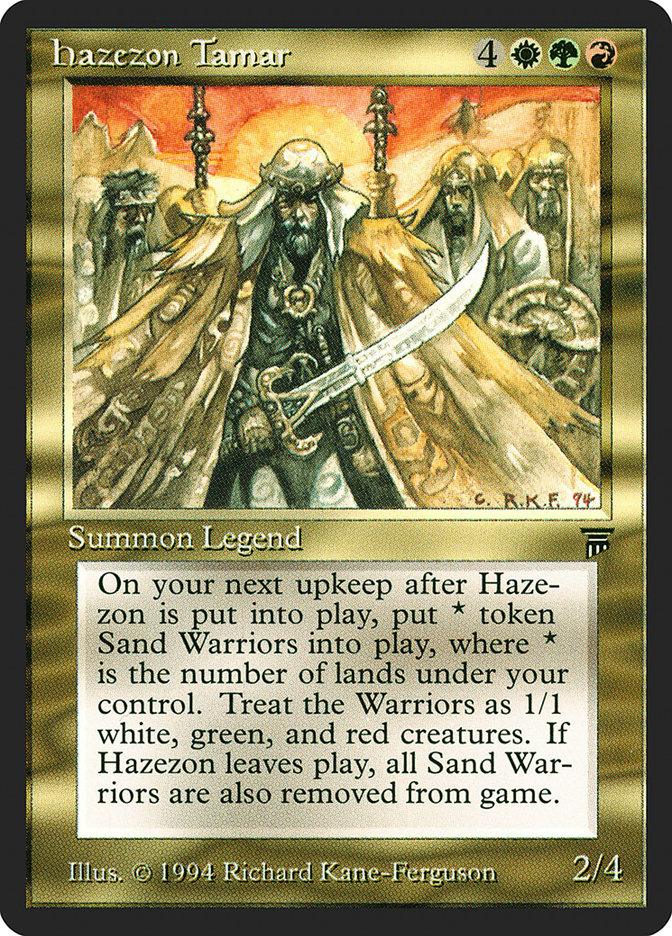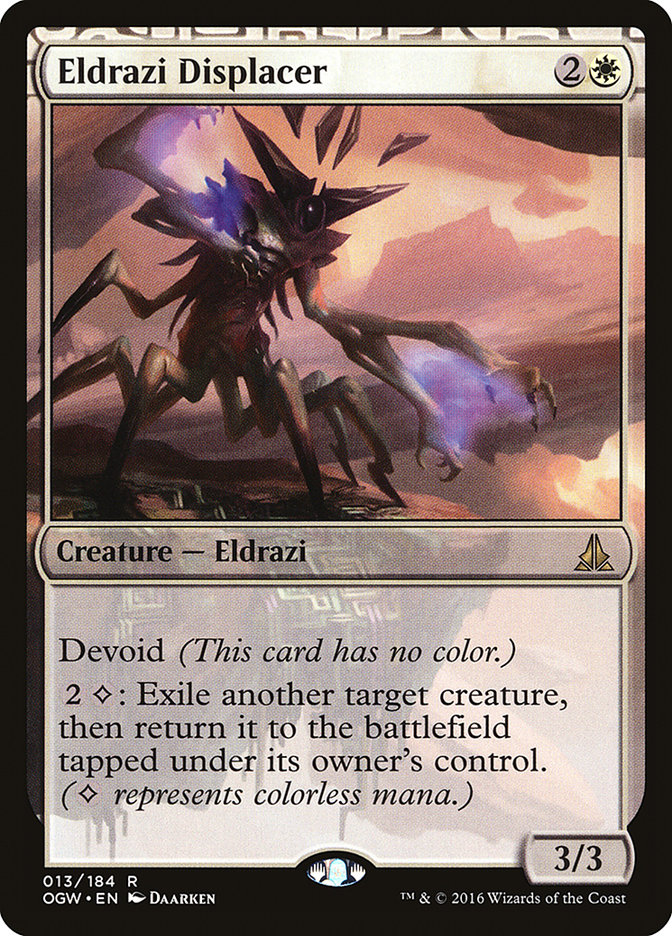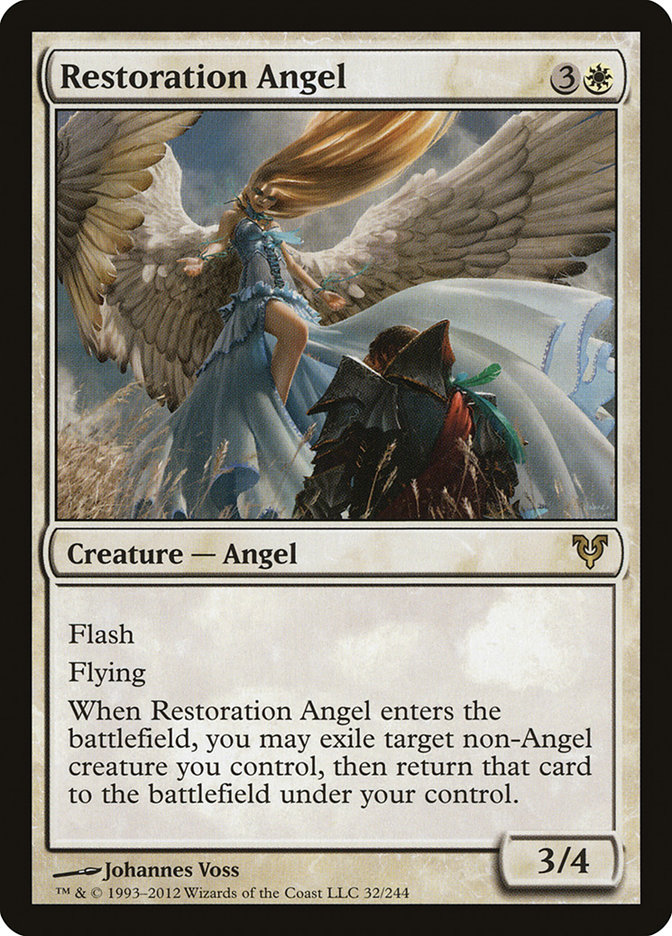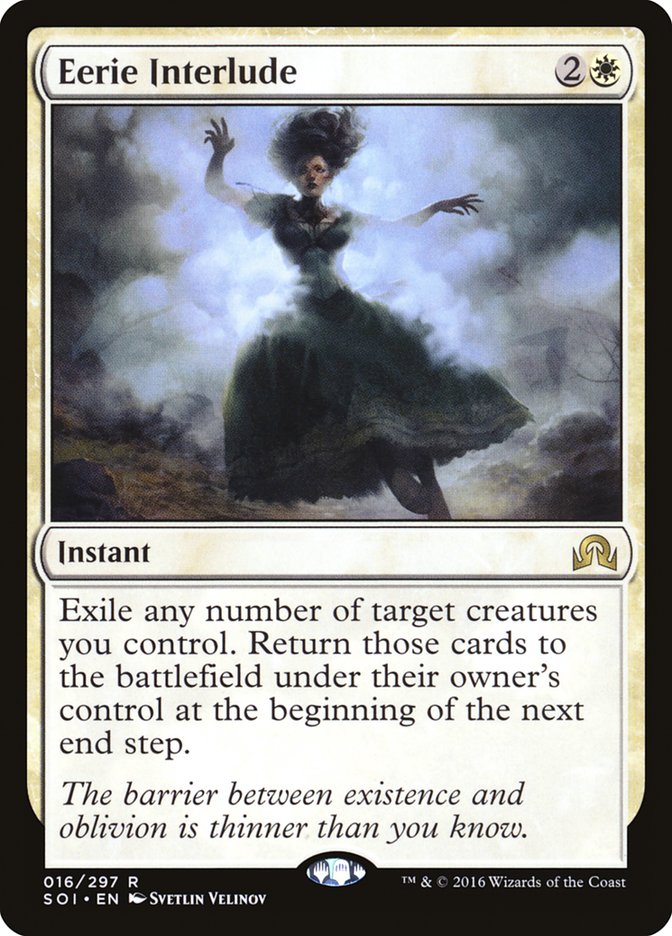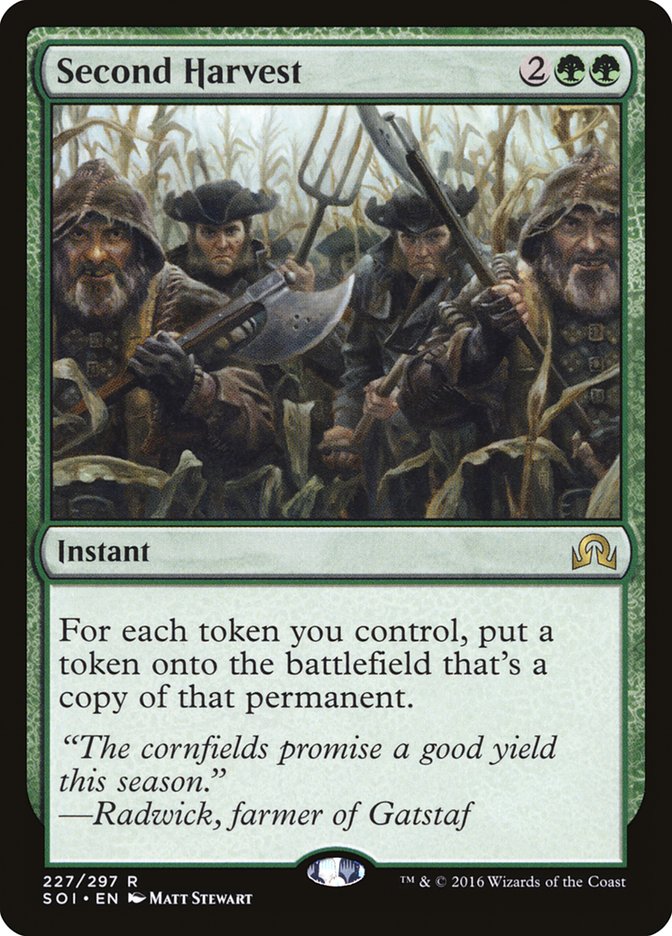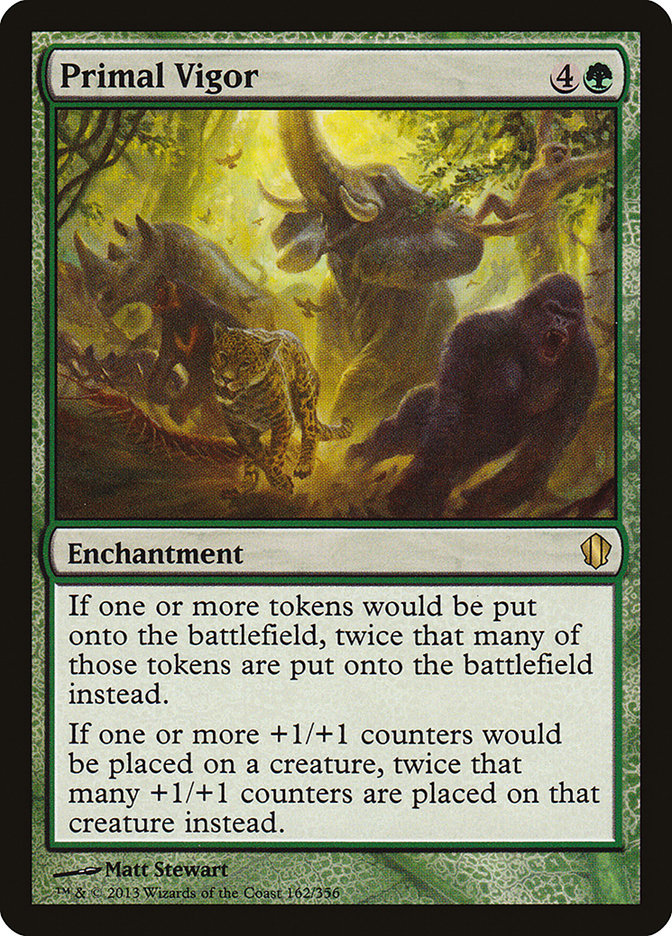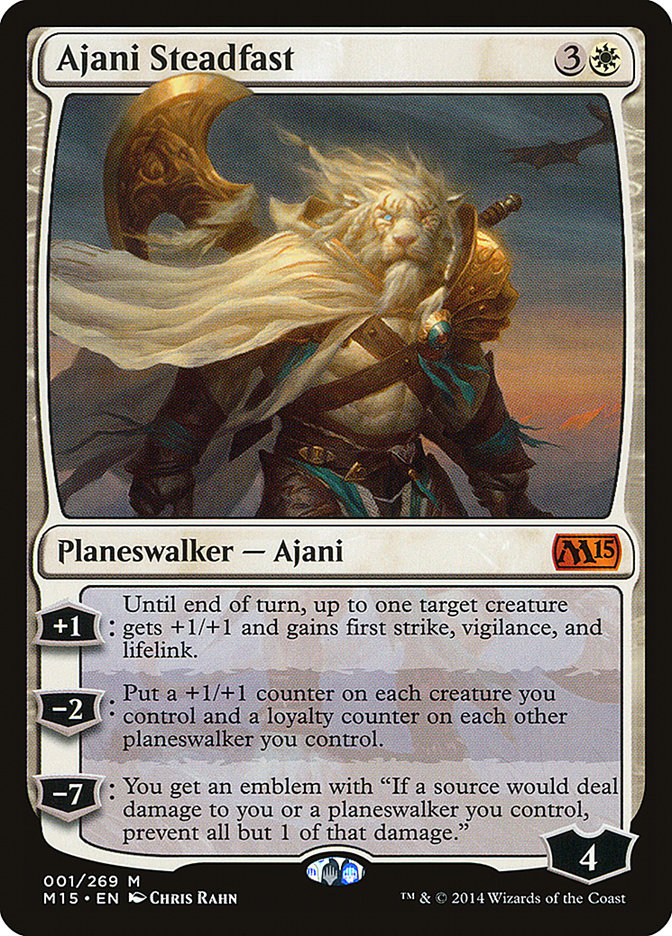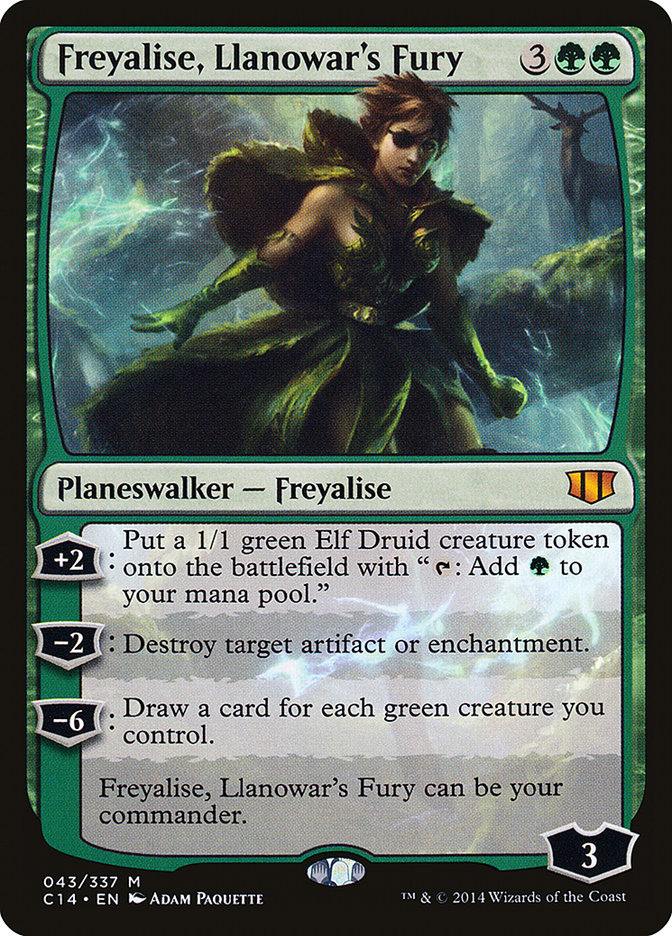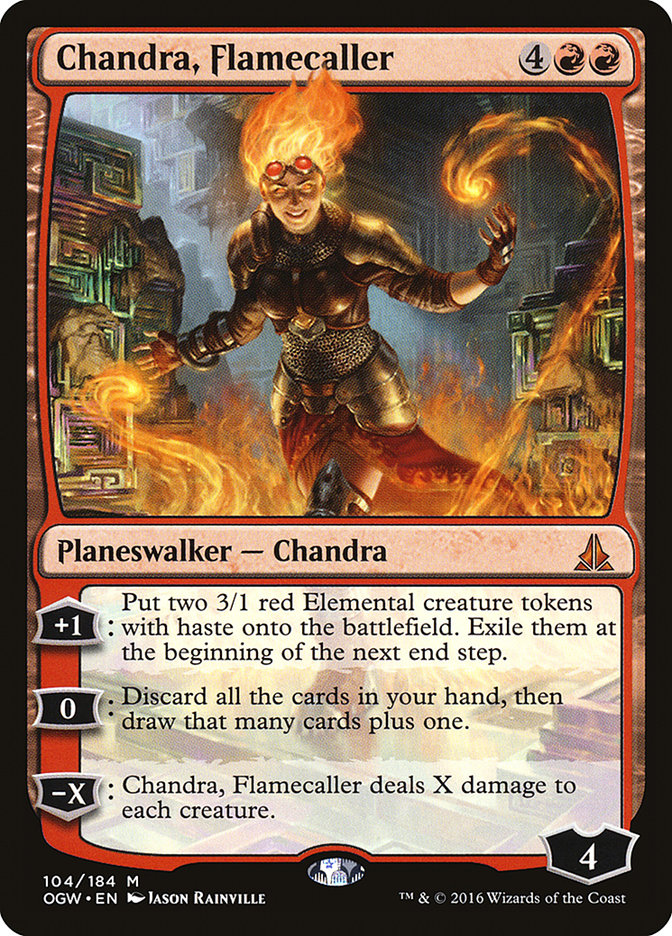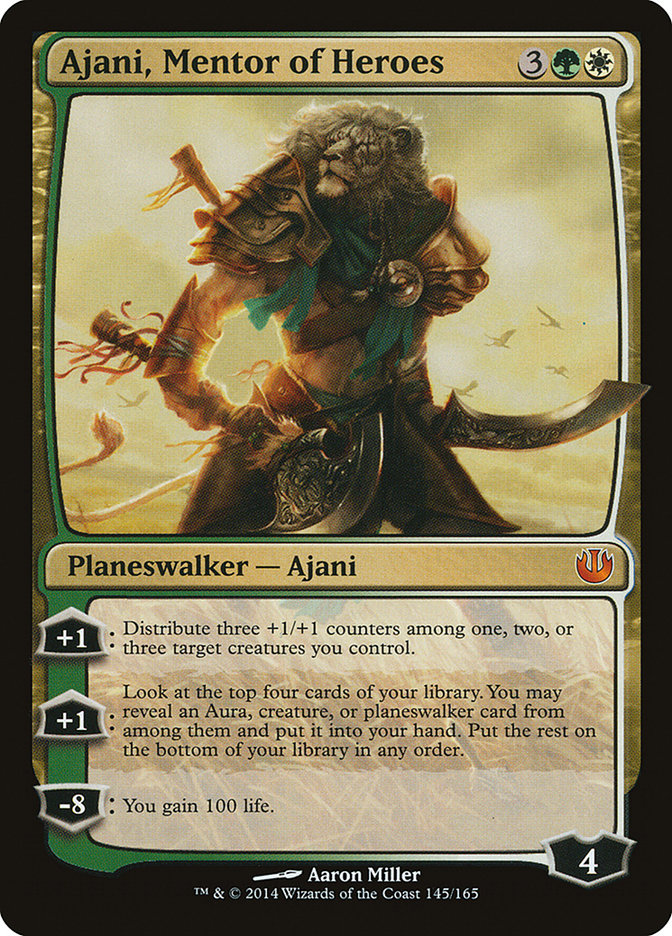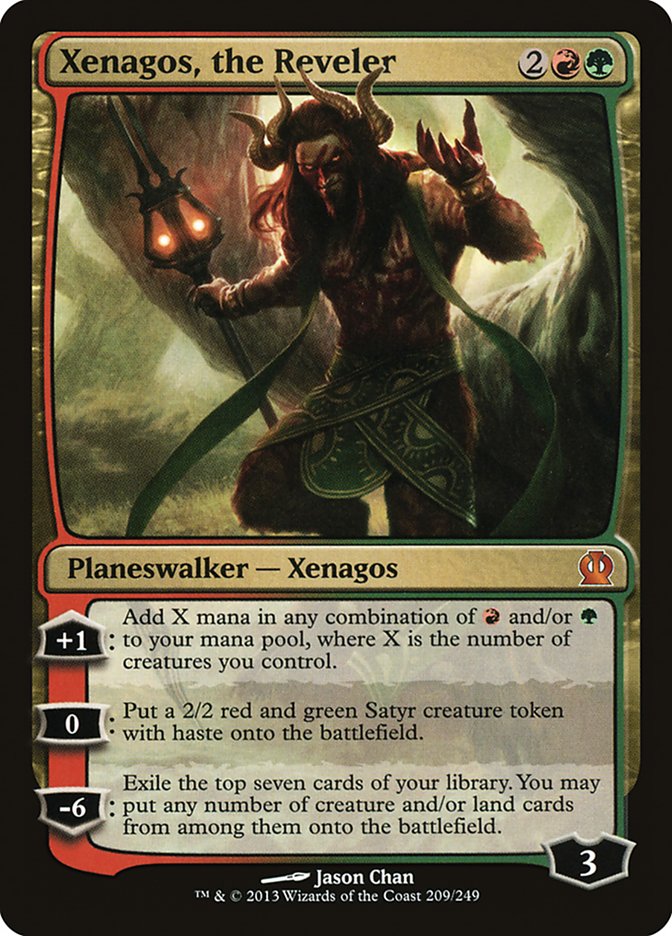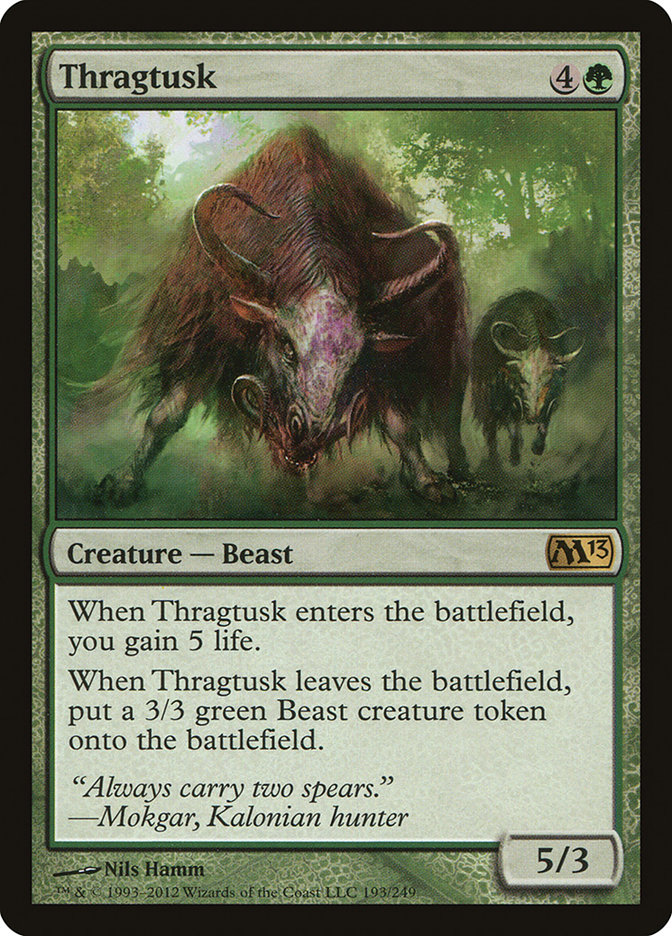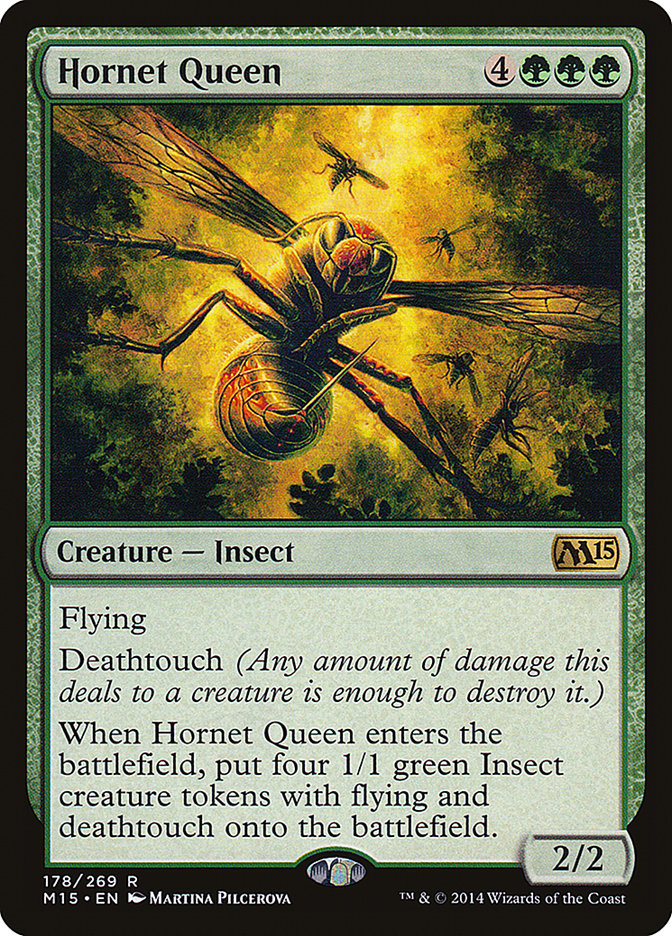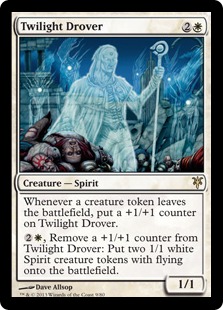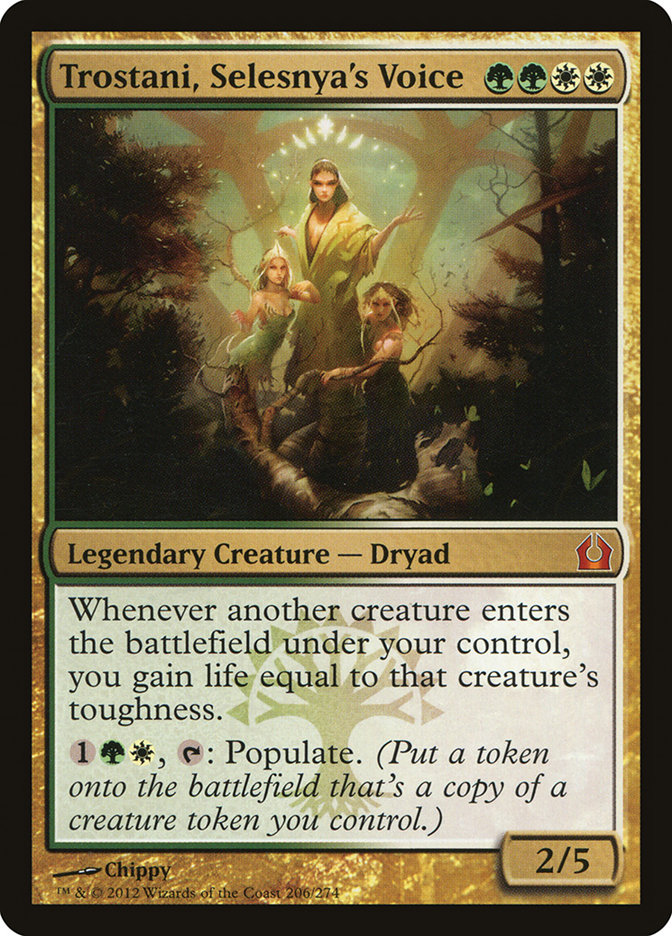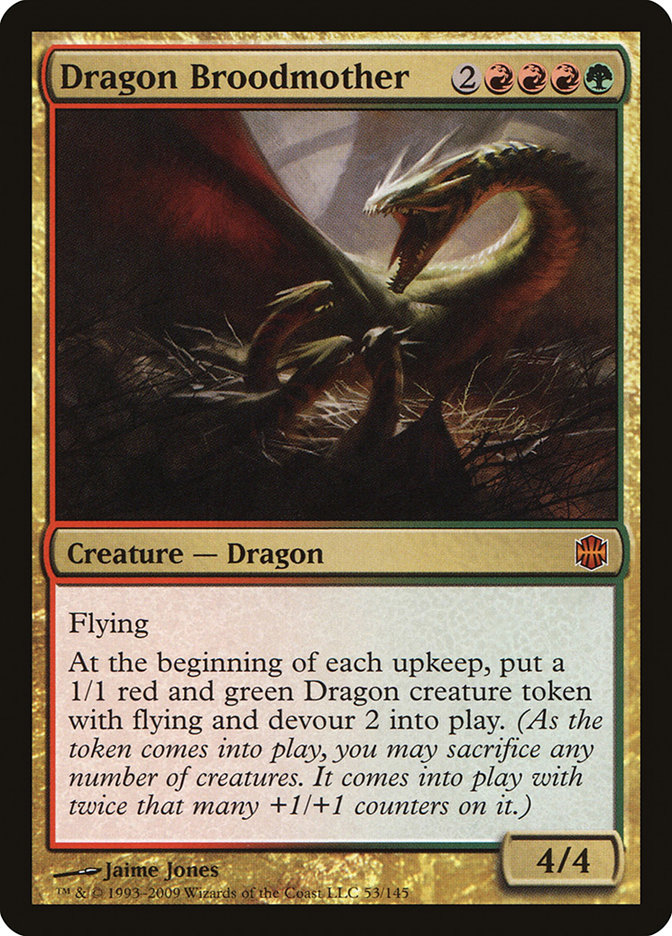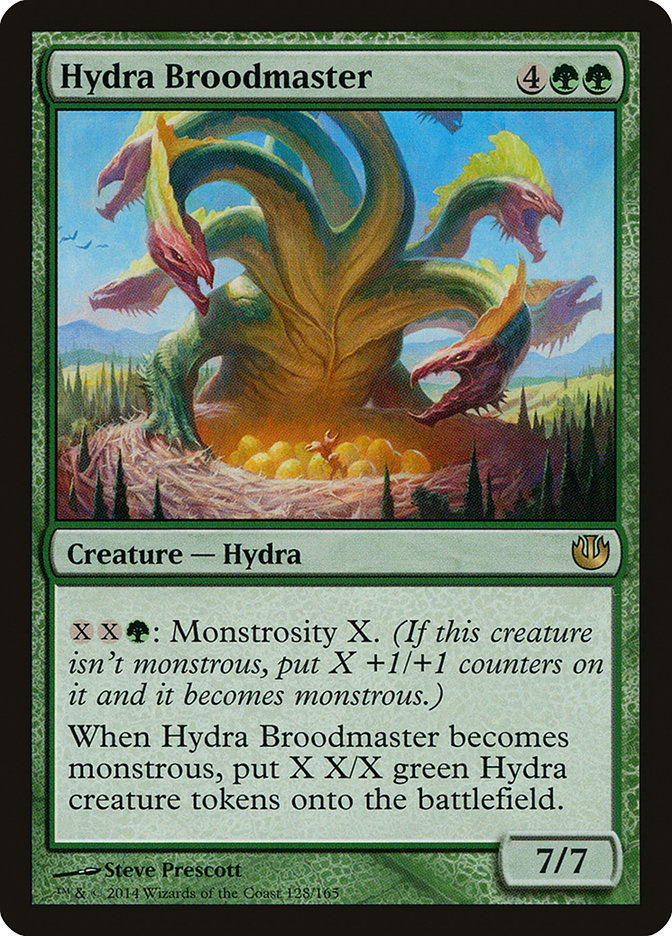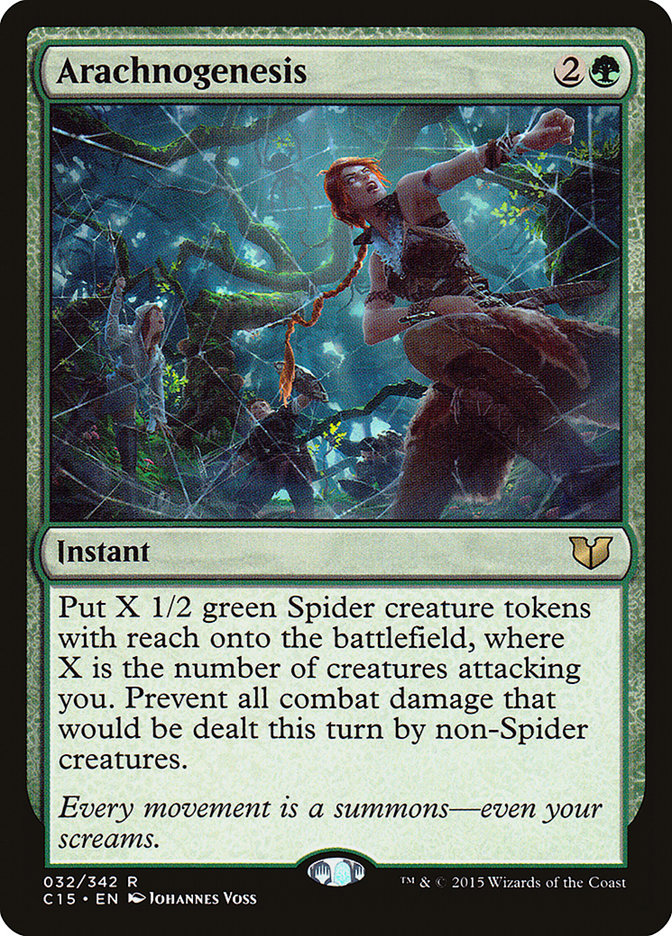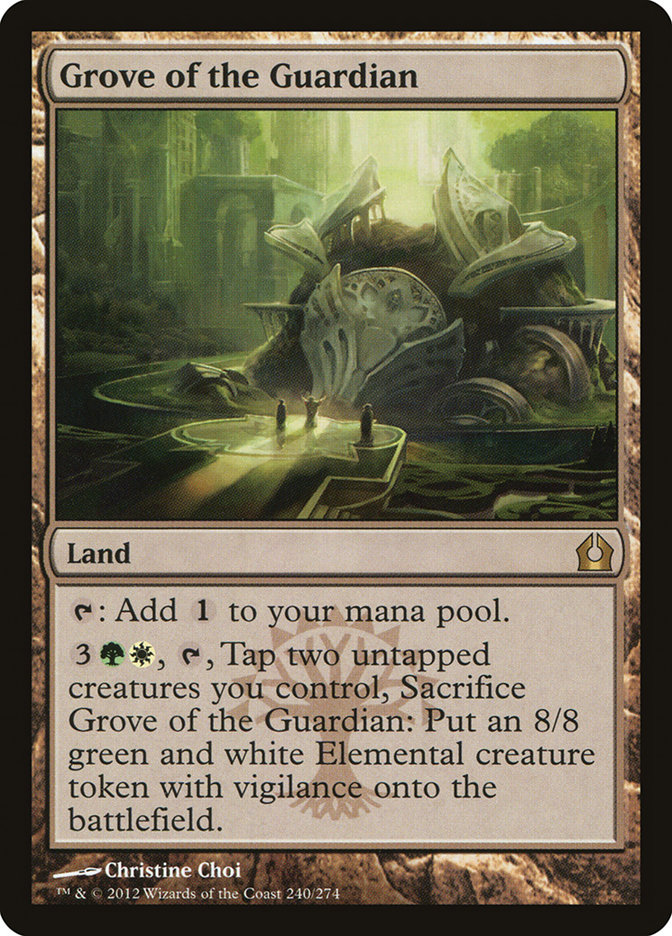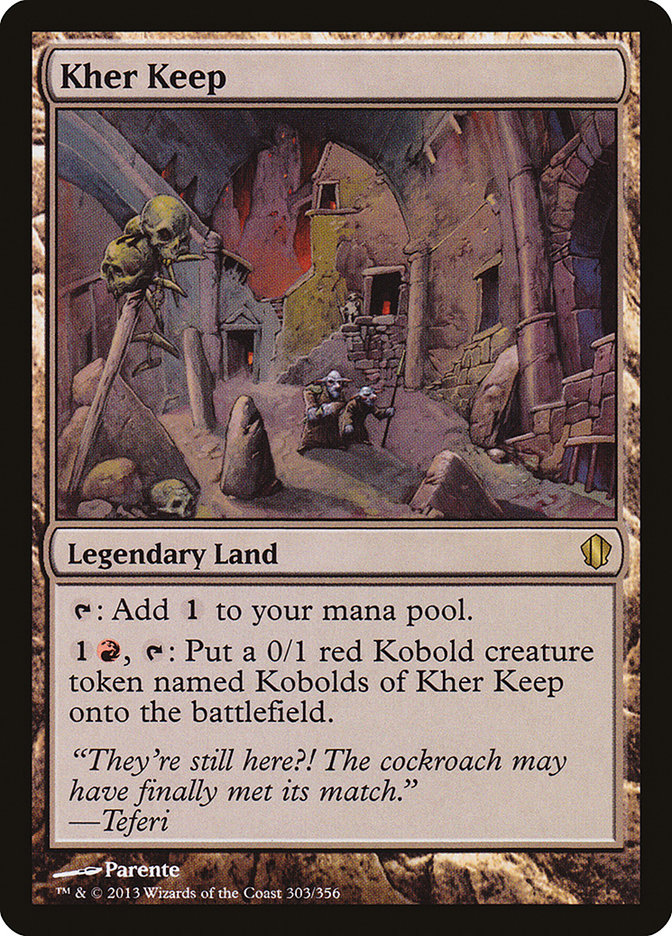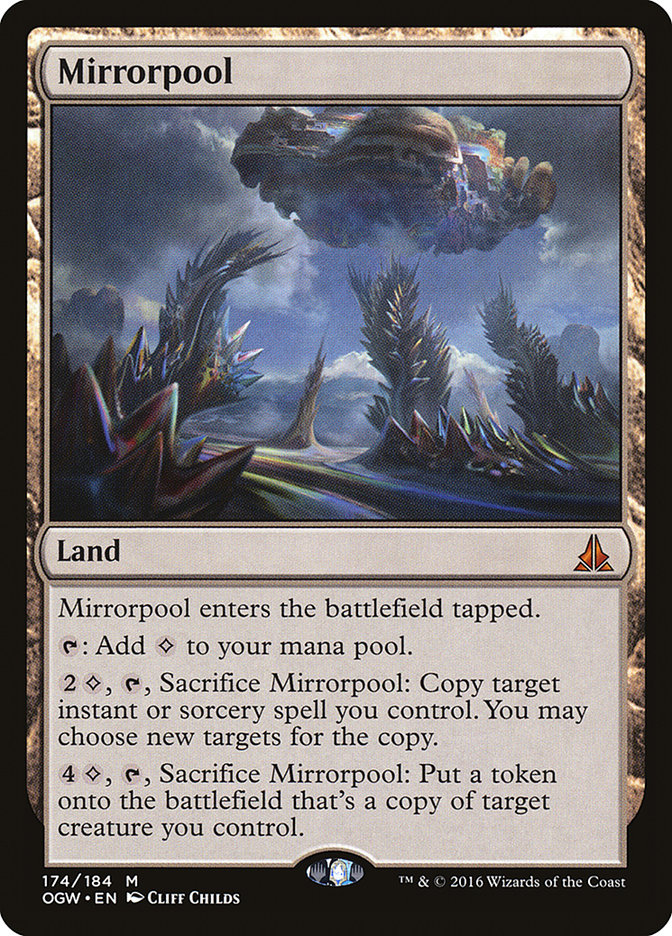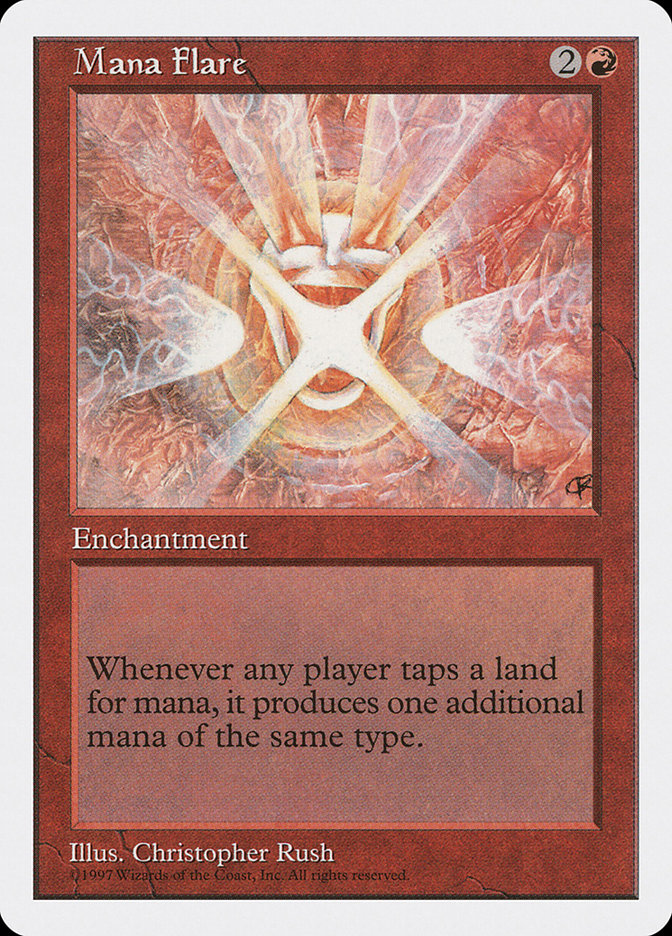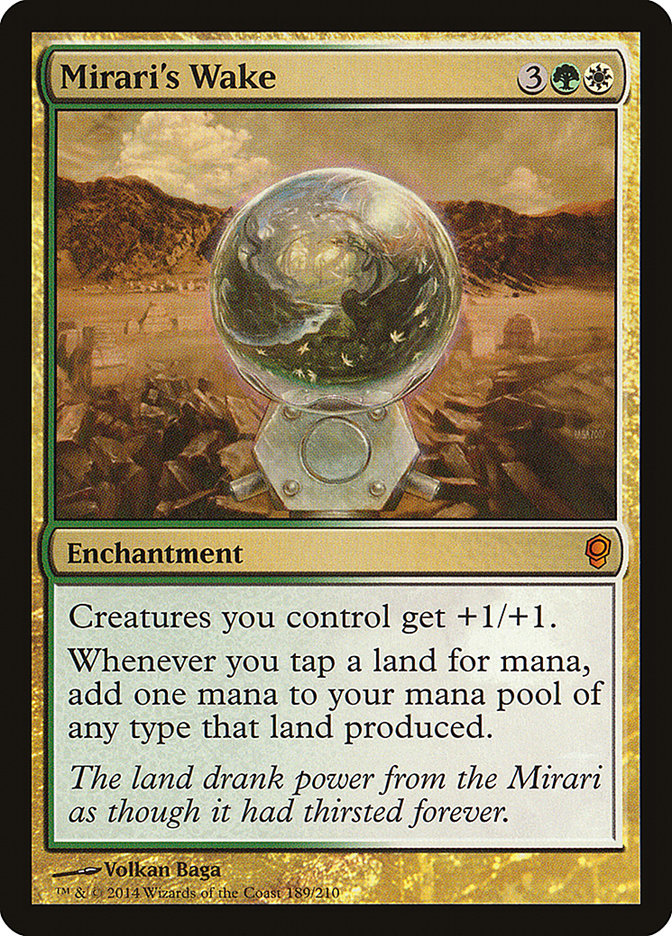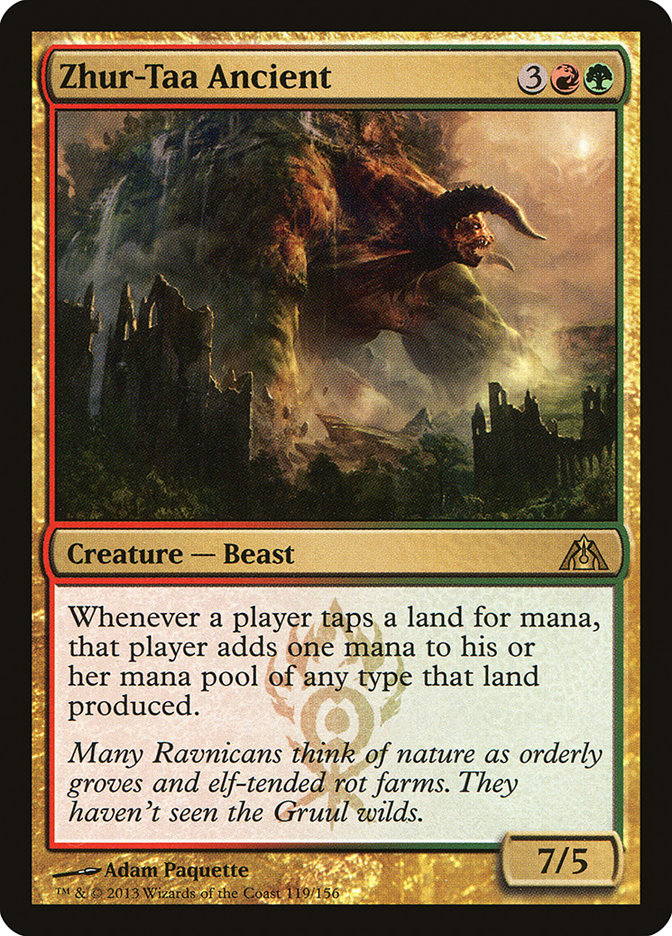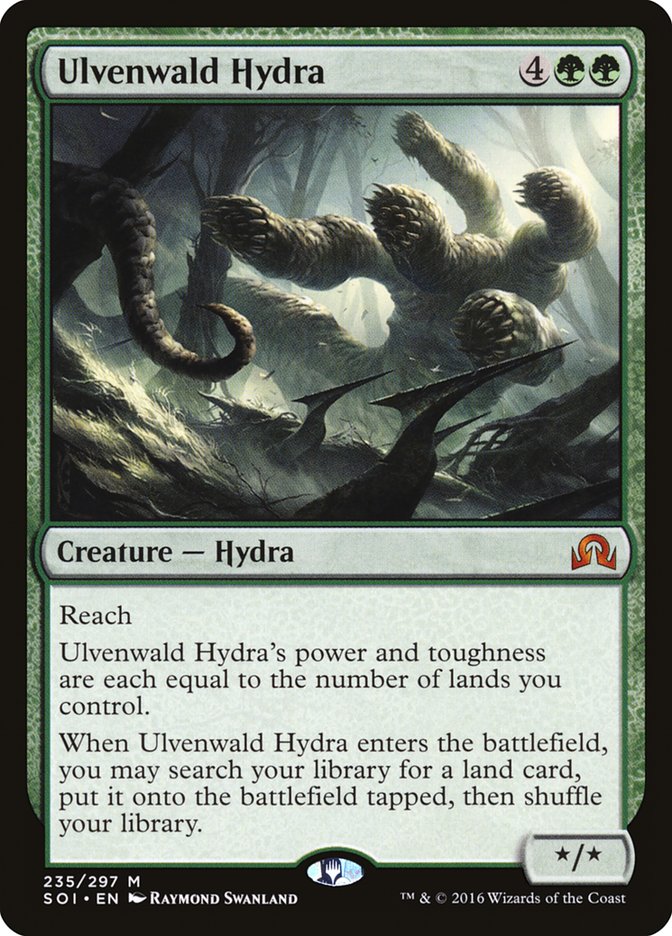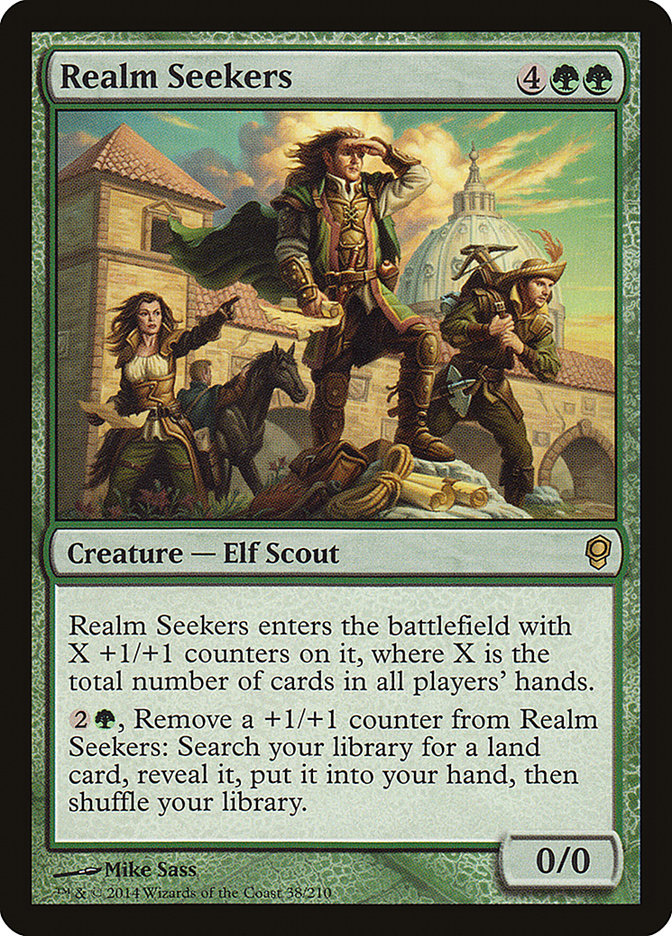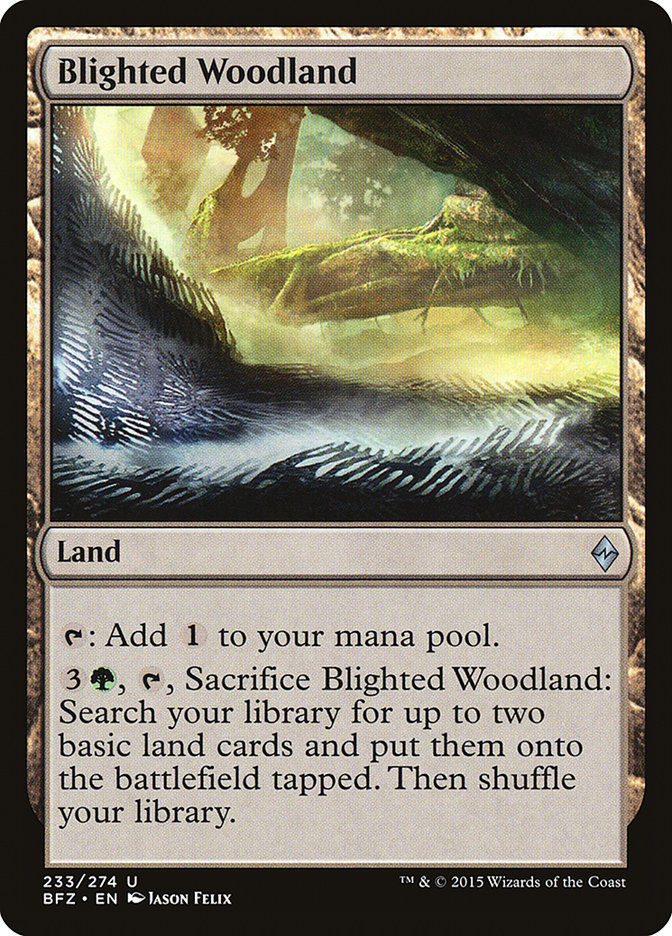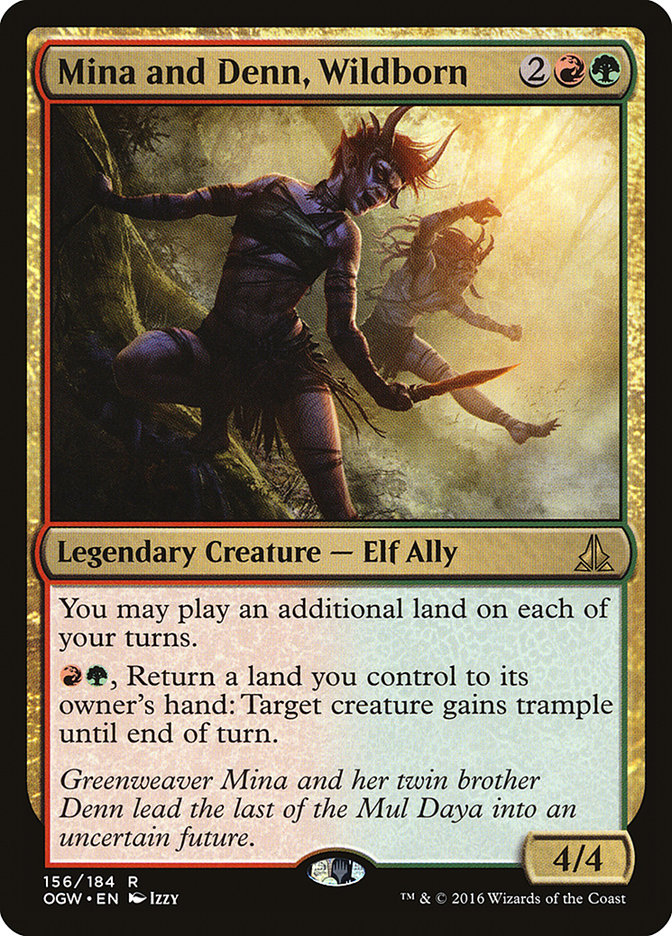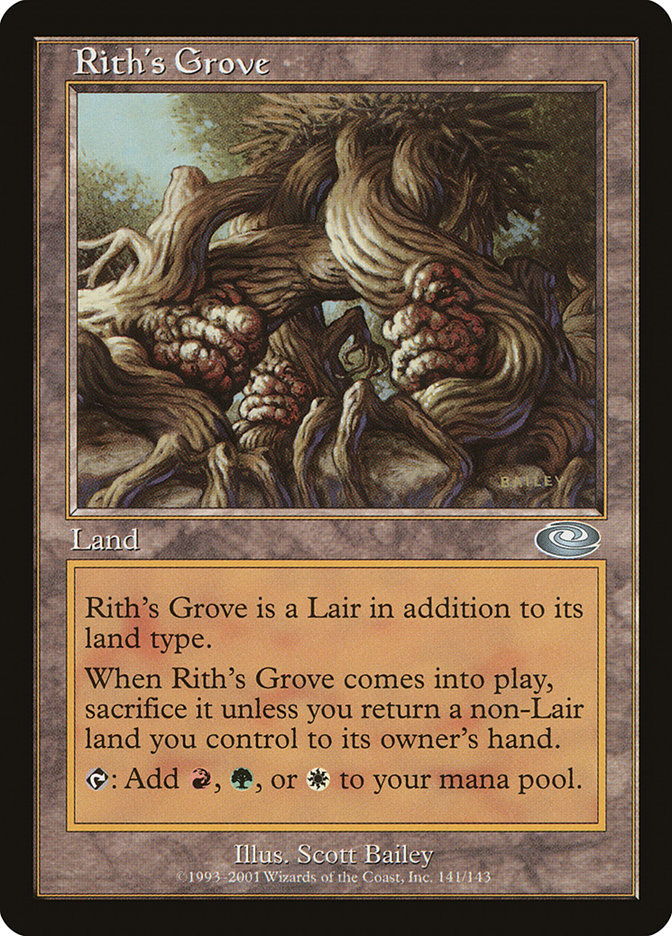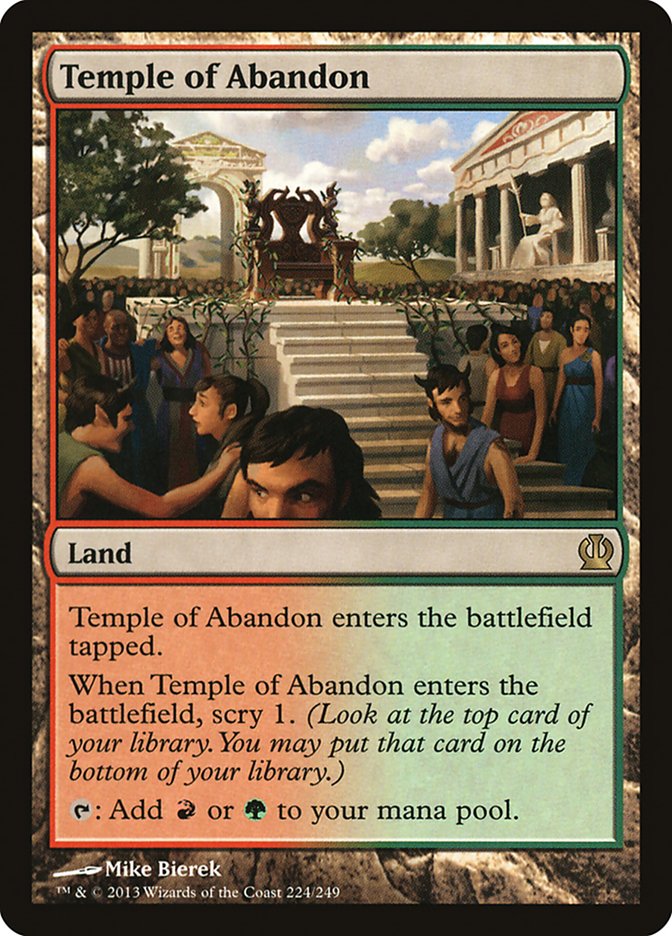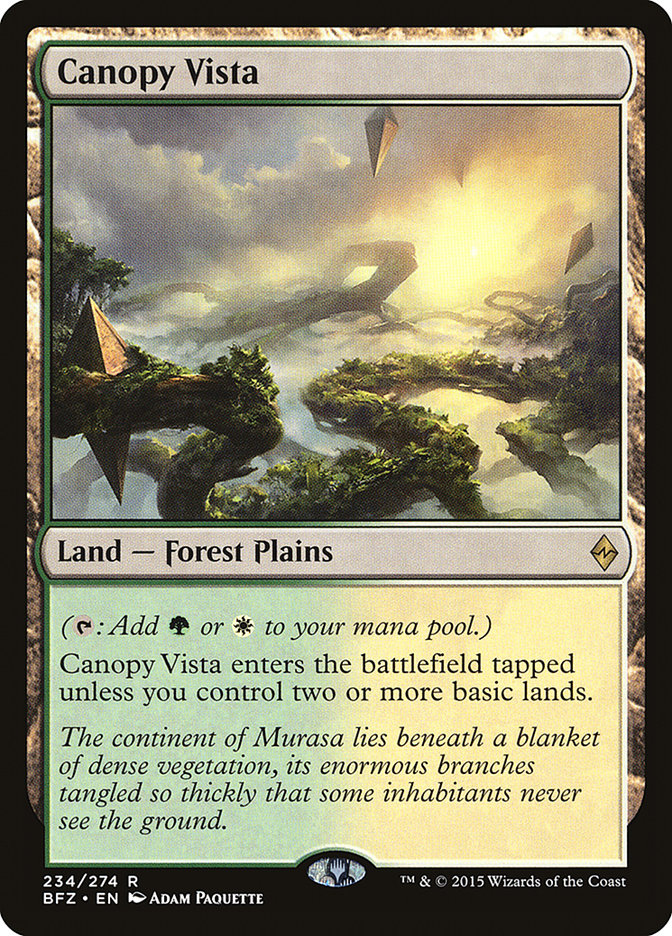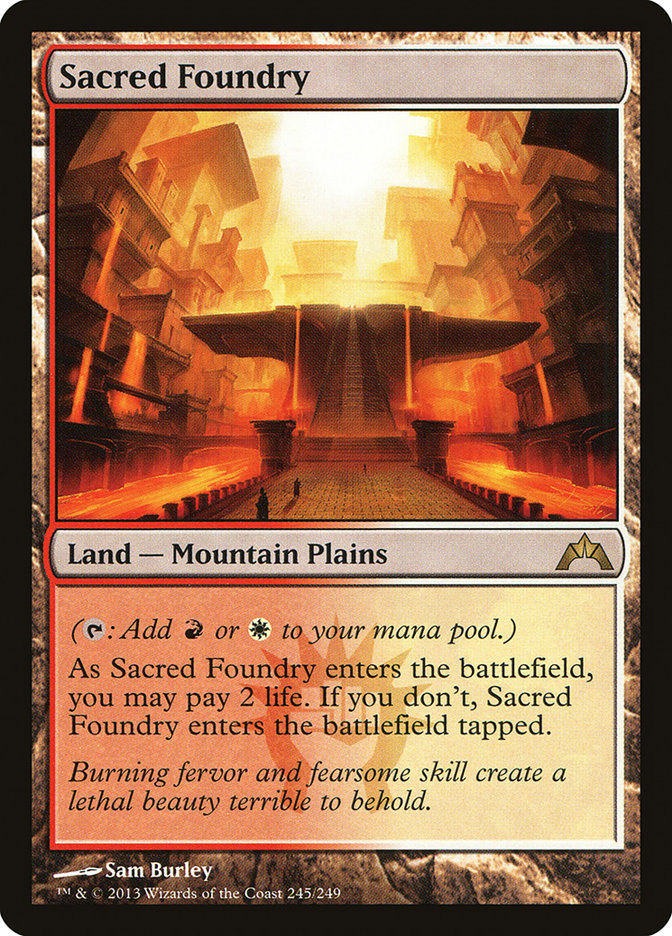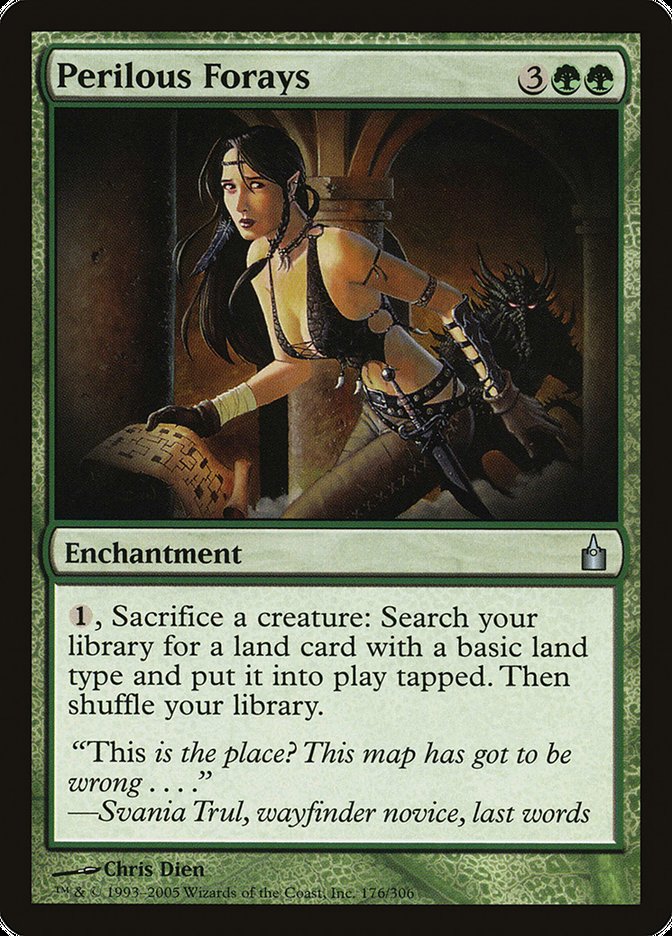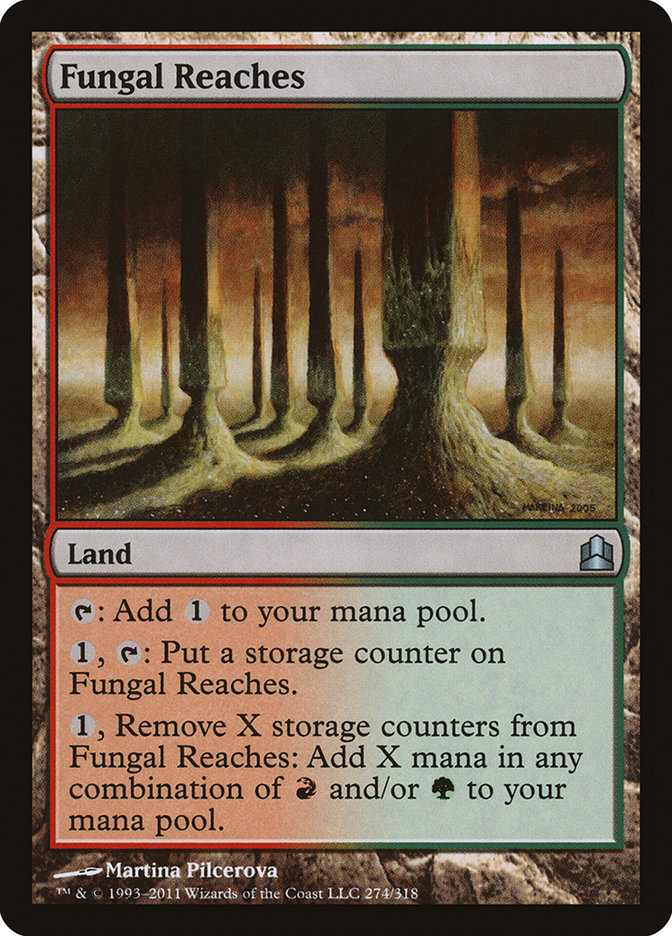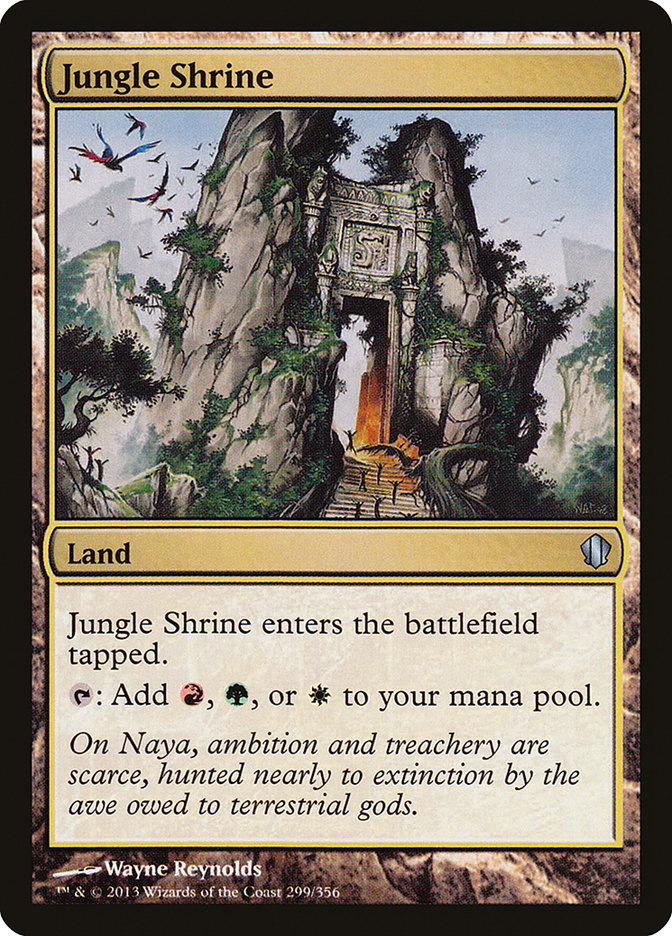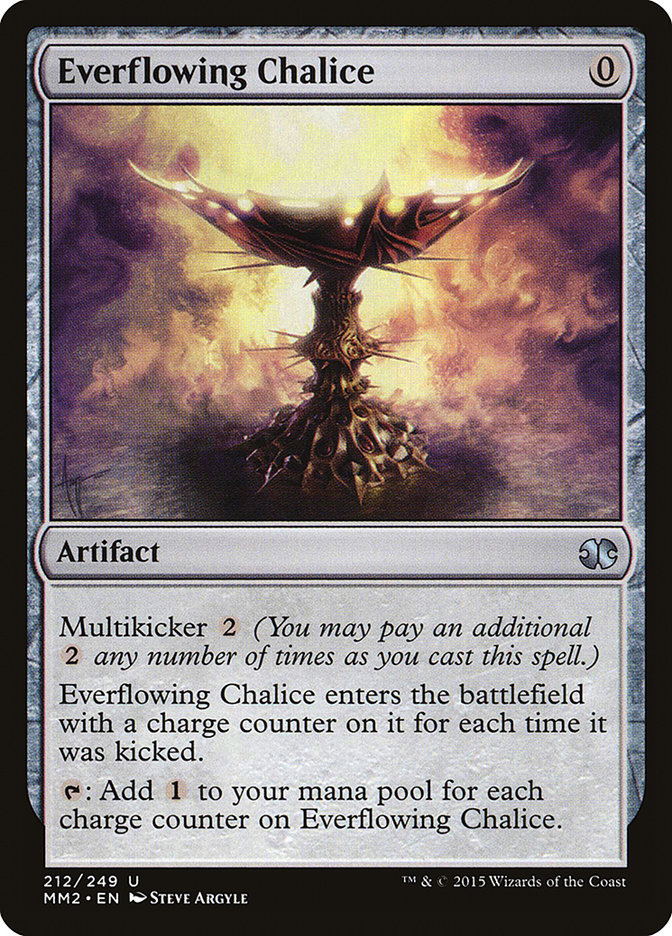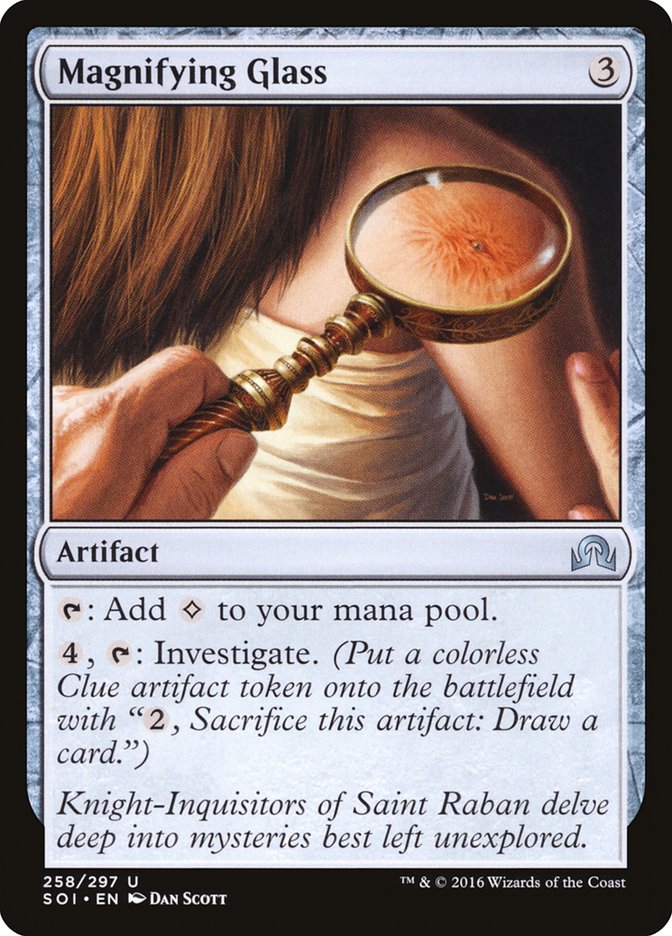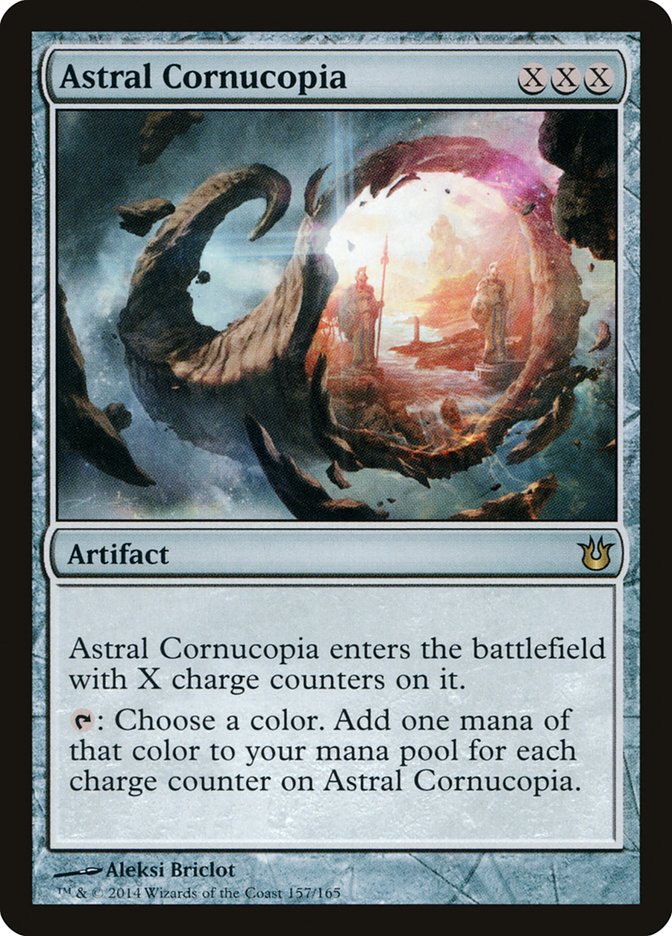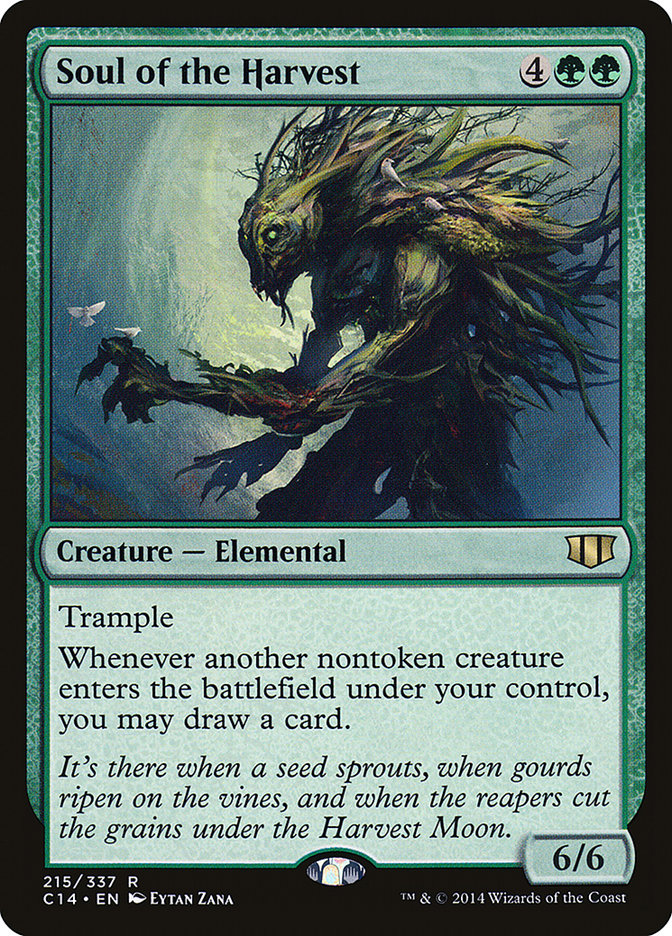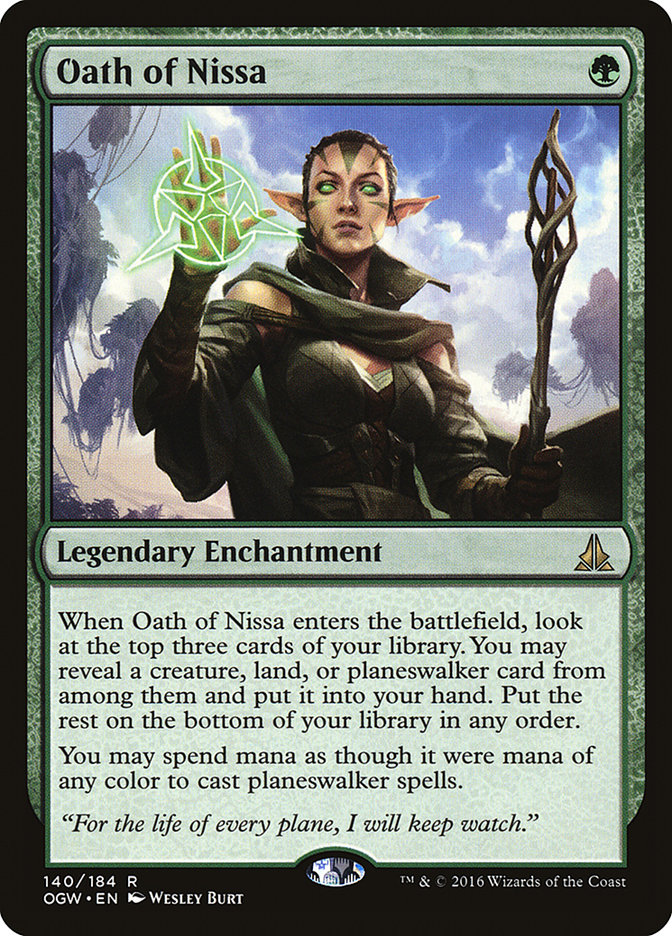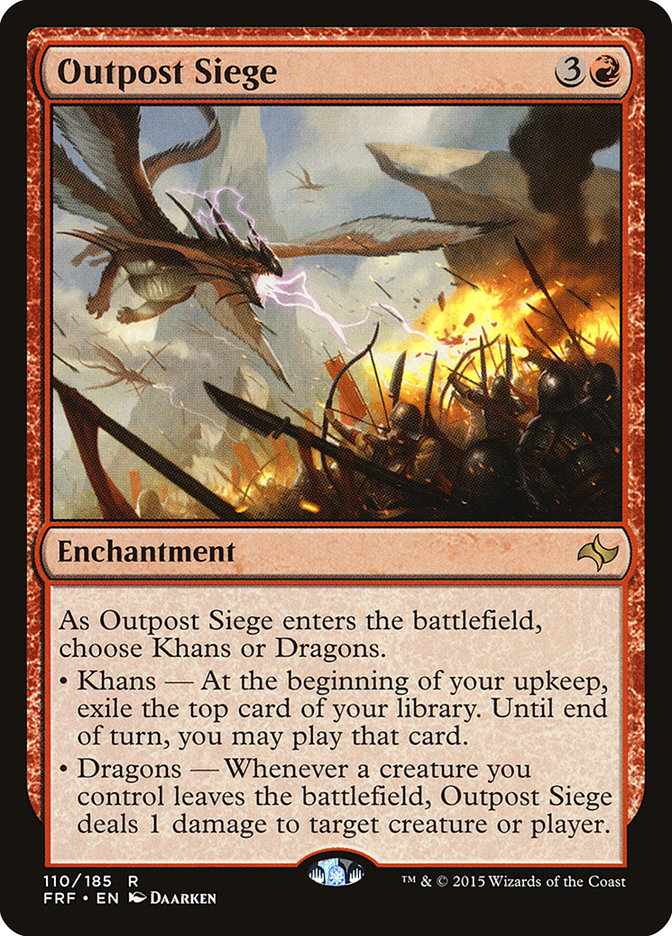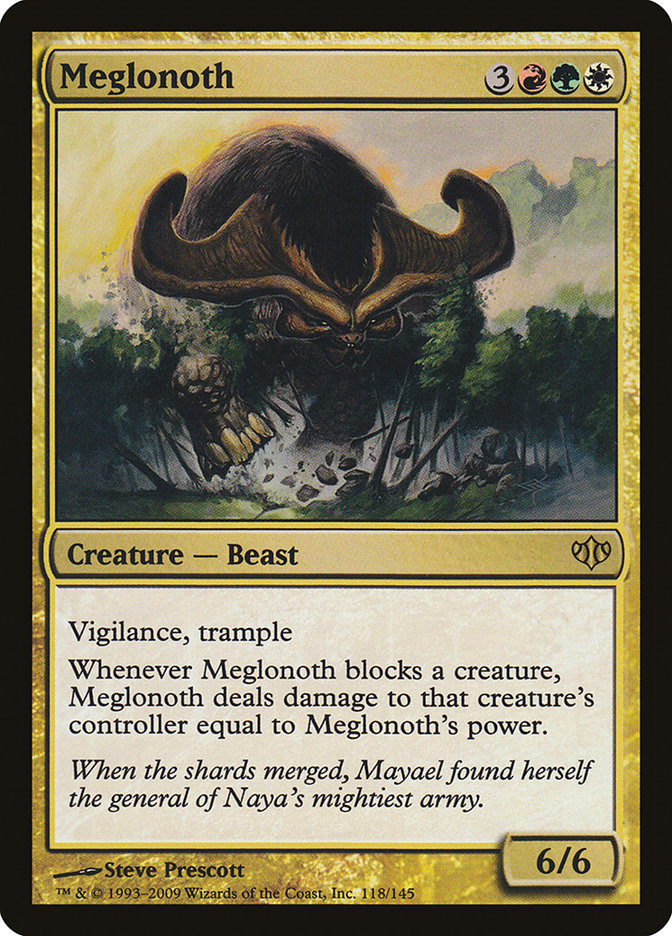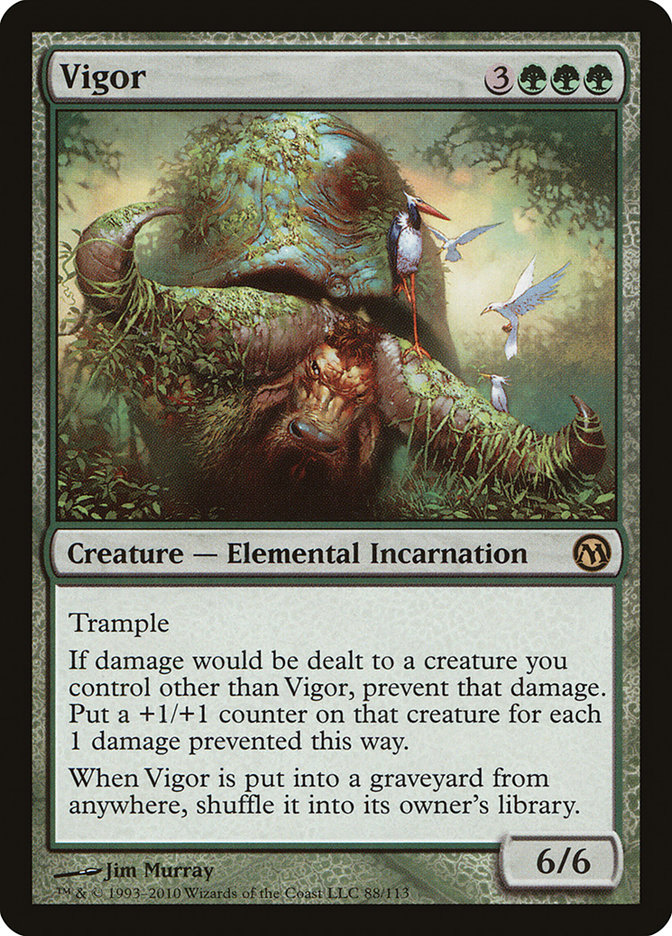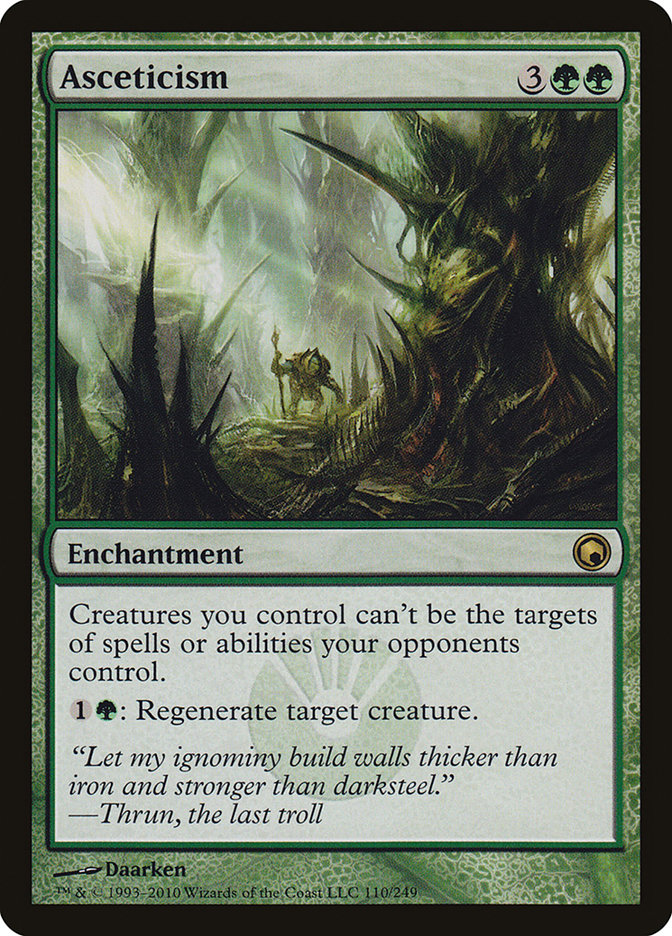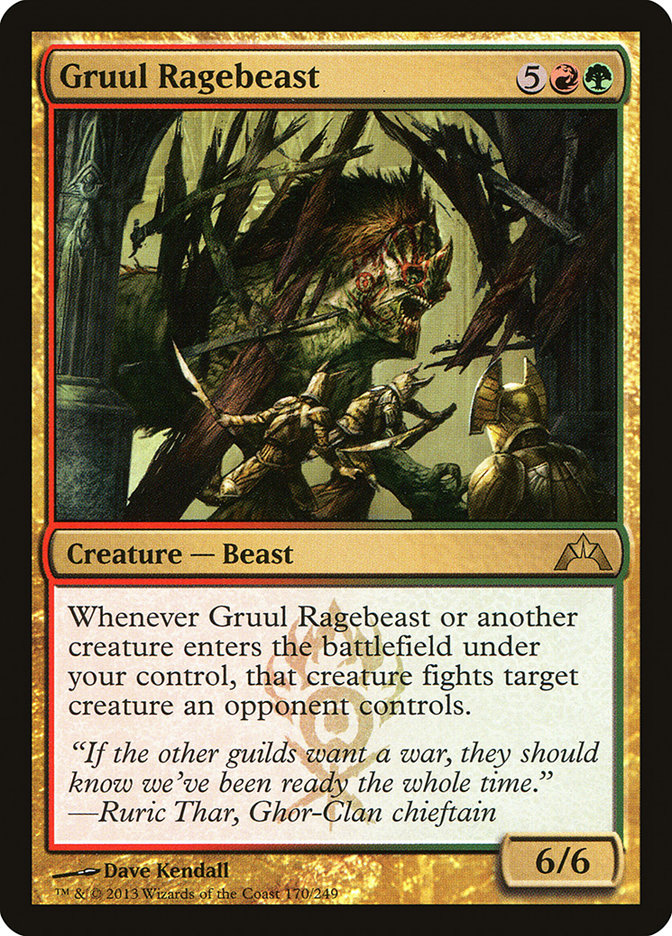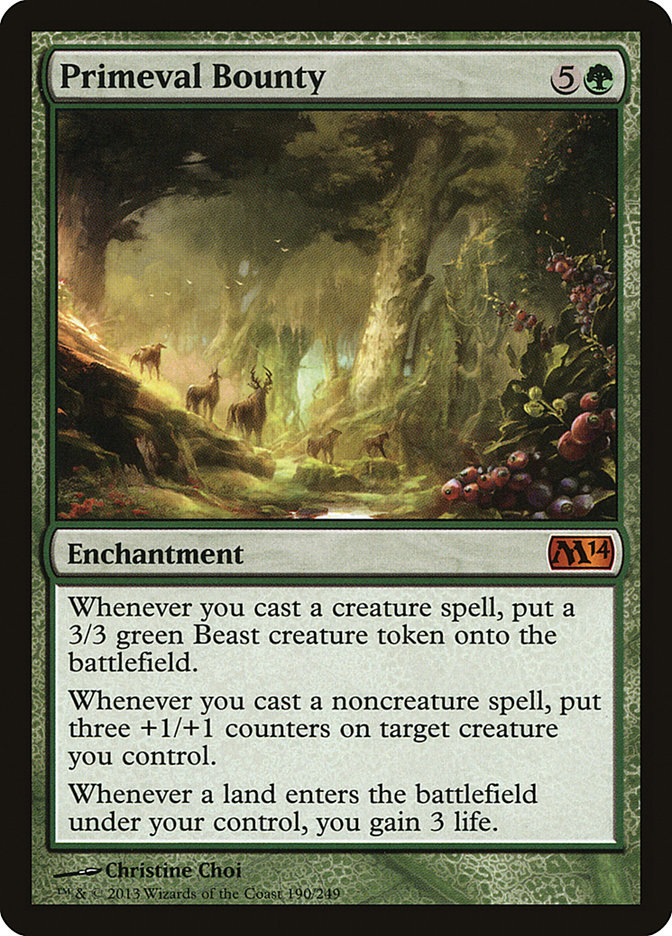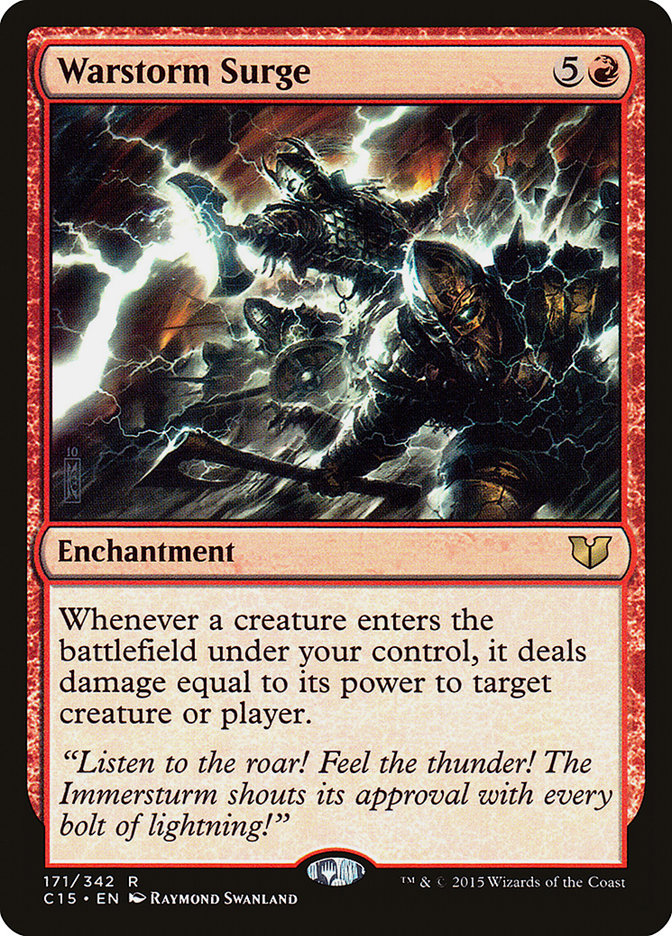We’re doing something a little different on Dear Azami. This week, we’re modifying one of the decks in my proverbial stable. I have an old Marath, Will of the Wild Doubling Season deck that hasn’t been updated since Future Sight, and my partner, Dana, has wanted to have a Hazezon Tamar deck for years. Recently I saw the opportunity to snag a copy for her, and as a birthday present I was planning on switching the deck over. And then I thought, “Hey, this is the perfect situation to show my work on a fairly radical transformation.”
Normally I like to try to keep decks relatively intact; this time I am cutting 53 cards. Assuming that there is an upper limit to the number of words I can reasonably expect a person to read, and that said limit would be way below the number of words it would take to examine each one in full, I have taken some liberties with the format. Indulge me.
Creatures (28)
- 1 Forgotten Ancient
- 1 Viridian Joiner
- 1 Twilight Drover
- 1 Vigor
- 1 Fertilid
- 1 Hateflayer
- 1 Keeper of Progenitus
- 1 Mycoloth
- 1 Apocalypse Hydra
- 1 Meglonoth
- 1 Avenger of Zendikar
- 1 Falkenrath Exterminator
- 1 Preyseizer Dragon
- 1 Wild Beastmaster
- 1 Gyre Sage
- 1 Gruul Ragebeast
- 1 Ivy Lane Denizen
- 1 Zhur-Taa Ancient
- 1 Polukranos, World Eater
- 1 Hundred-Handed One
- 1 Polis Crusher
- 1 Nessian Wilds Ravager
- 1 Scourge of Skola Vale
- 1 Realm Seekers
- 1 Custodi Soulbinders
- 1 Dragonscale General
- 1 Dromoka, the Eternal
- 1 Battlefront Krushok
Planeswalkers (3)
Lands (19)
- 1 Rith's Grove
- 1 Temple of the False God
- 1 Boros Garrison
- 1 Selesnya Sanctuary
- 1 Sunhome, Fortress of the Legion
- 1 Gruul Turf
- 1 Skarrg, the Rage Pits
- 1 Fungal Reaches
- 1 Saltcrusted Steppe
- 1 Mosswort Bridge
- 1 Jungle Shrine
- 1 Oran-Rief, the Vastwood
- 1 Kessig Wolf Run
- 1 Gavony Township
- 1 Slayers' Stronghold
- 1 Selesnya Guildgate
- 1 Gruul Guildgate
- 1 Boros Guildgate
- 1 Opal Palace
Spells (49)
- 1 Heartbeat of Spring
- 10 Forest
- 5 Plains
- 1 Mana Flare
- 1 Sol Ring
- 5 Mountain
- 1 Mirari's Wake
- 1 Doubling Season
- 1 Perilous Forays
- 1 Rites of Flourishing
- 1 Mana Reflection
- 1 Mayael's Aria
- 1 Basilisk Collar
- 1 Everflowing Chalice
- 1 Contagion Clasp
- 1 Contagion Engine
- 1 Command Tower
- 1 Death's Presence
- 1 Wear
- 1 Pure
- 1 Primeval Bounty
- 1 Bow of Nylea
- 1 Primal Vigor
- 1 Astral Cornucopia
- 1 Dictate of Karametra
- 1 Solidarity of Heroes
- 1 Sylvan Offering
- 1 Shamanic Revelation
- 1 Outpost Siege
- 1 Citadel Siege
- 1 Abzan Advantage
- 1 Map the Wastes

In what is truly a beautiful piece of symmetry, this deck is based off the first deck I ever doctored for Dear Azami in It’s Hip To Be Squared. That Rosheen Meanderer deck looked fun, and I wanted to get the chance to play with a bunch of doublers. Spoiler alert: it was a lot of fun! But it’s not exactly my favorite deck in this archetype. My preferred Doubling Season deck is Ghave, Guru of Spores doing the “double tokens” thing; Marath, Will of the Wild became more of a “double counters” deck after Khans of Tarkir and Fate Reforged. As a result, I never really went back to the deck after Fate Reforged.
Hazezon Tamar is a legendary creature from Legends. This means that his cool ability is not properly templated. Want to see?
The Oracle text is a bit cleaner:
When Hazezon Tamar enters the battlefield, put X 1/1 Sand Warrior creature tokens that are red, green, and white onto the battlefield at the beginning of your next upkeep, where X is the number of lands you control at that time. When Hazezon leaves the battlefield, exile all Sand Warriors.
Immediately two things jump out at me when looking at this card: it’s a token generator, and it has a tie to lands. Dana, when I explained the project to her, added in another angle: Flicker effects, to take advantage of the templating of the ability.
Basically, if you Flicker it a couple of times in the same turn, you build up a bunch of triggered effects in your next upkeep. Then they all go off one by one during your next turn, and you can even do gross things like use Ashnod’s Altar and Perilous Forays to mulitiply your land count by 150% every trigger, or just use Ashnod’s Altar to kill Hazezon Tamar before your next upkeep so you get to keep the Sand Warriors around for as long as you need them.
I did not include Ashnod’s Altar, however, because lately I’ve been having some mixed feelings about the true degeneracy of the card. It is amazing, but it enables many combos while helping a fair number of the midrange decks as well. This deck doesn’t need the mana, since it should be getting plenty through its doublers.
Given the degree of change, I felt the usual one-for-one discussion of cards removed in favor of those added would be counterproductive. Instead, working from the final decklist, I’m going to talk about each theme as a whole in the final product.
Flicker
In (5): Eldrazi Displacer, Solemn Simulacrum, Restoration Angel, Stormfront Riders, Eerie Interlude
To begin, Dana had requested a Flicker subtheme. She really liked the idea of flickering Hazezon Tamar in order to double up on tokens. I had already been drawn to the idea of creatures that create tokens in support of Hazezon Tamar’s ability, like with like and all, but the desire for a Flicker subtheme was the final push needed to commit to that strategy.
Here you see a couple of enablers. I favor Eldrazi Displacer and Restoration Angel in general. In this case, where there’s a “creatures who create tokens” subtheme, I find Stormfront Riders to be a good fit. It will let you buy back your Mulldrifters while leaving tokens in its wake, and it can pick itself up incidentally. For five mana you can return one of your creatures to your hand and get (at least) two Soldier tokens, as many times as you want or need. It’s a good fit.
I scoffed when Eerie Interlude was reprinted instead of Ghostway, but one of my brilliant judge friends pointed out that, while Ghostway is terrible with token strategies, something like Eerie Interlude lets you reset just the token-making Mulldrifters, leaving you with two generations of tokens. He was totally right, so it’s a good fit with what this deck wants to be doing.
Doubling Seasons
In (4): Parallel Lives, Second Harvest, Doubling Season, Primal Vigor
The basic suite of these effects. Second Harvest looks to make as lasting an impression as Parallel Lives has, which is not entirely complimentary. I mean, I didn’t feel the need to also add in Parallel Evolution. It is possible to have too many of these effects. Primal Vigor is a lot less symmetrical when you build around it, but beware running into another tokens deck.
And then there’s Doubling Season. The gold standard. I love that card, but it can cause balance issues when you play to its power. I know Dana’s play style, though; I’m going to let loose with this one.
Tokens
Planeswalkers (9): Oath of Gideon; Nissa, Voice of Zendikar; Ajani Steadfast; Xenagos, the Reveler; Ajani, Mentor of Heroes; Freyalise, Llanowar’s Fury; Garruk, Primal Hunter; Elspeth, Sun’s Champion; Chandra, Flamecaller
Planeswalkers love Doubling Season. You can completely lean into theme, which is fun and involves several more Ajani-type planeswalkers. I chose to only somewhat lean into it, only bringing in two Ajani planeswalkers. Each planeswalker is one I would run in this deck even if Doubling Season were templated like Primal Vigor; Ajani Steadfast, for example, would be included as another means of adding planeswalker loyalty even without a Doubling Season boost.
Ajani, Mentor of Heroes is going to be primarily a draw engine, but he also offers the ability to immediately gain you 100 life if Doubling Season is on the battlefield. Even better, if you also have Oath of Gideon on the battlefield, which will spawn four tokens with Doubling Season, Ajani, Mentor of Heroes can gain you 100 life and still stick around. That’s pretty cool. I mean, in Commander 100 life isn’t necessarily a problem, since commander damage, combo, and some truly spectacular Timmy decks exist. But it’s a cool thing to check off the bucket list.
Xenagos, the Reveler ultimates with Doubling Season, provides tokens, and then can ramp you significantly once your token multiplication comes online. Nissa, Voice of Zendikar makes tokens and threatens to draw you a ton of cards while having backup utility as an Anthem. Garruk, Primal Hunter promises either a swarm of Wurms for your Sand Warriors to ride or just to draw you a bunch of cards. Either way, it sounds like a win. Chandra, Flamecaller is removal, tokens, and draw; Elspeth, Sun’s Champion is removal, tokens, and Overrun; Freyalise, Llanowar’s Fury is draw, removal, and tokens.
A permanent that can reliably do three different powerful things seems like a good card for Commander.
Flicker (8): Huntmaster of the Fells, Pia and Kiran Nalaar, Thragtusk, Cloudgoat Ranger, Captain of the Watch, Armada Wurm, Avenger of Zendikar, Hornet Queen
Let’s also check back in on our Flicker theme. These cards create tokens when they enter the battlefield, making them pair well with cards like Eldrazi Displacer. There is one exception to this rule, Thragtusk, but its “leaves the battlefield” trigger means it plays even better with Stormfront Rider than most of the other cards. Pia and Kiran Nalaar and Huntmaster of the Fells double as removal, and Hornet Queen is one of the hardest cards to beat through in a stalled battlefield, especially when you’re spawning more Insects every turn.
And the interaction between Avenger of Zendikar and Nissa, Voice of Zendikar is just icing on a very thematic cake.
Repeating (7): Dragon Whisperer; Twilight Drover; Custodi Soulbinders; Trostani, Selesnya’s Voice; Mycoloth; Dragon Broodmother; Sacred Mesa
Speaking of spawning every turn, these cards all offer repeatable token generation, mostly for mana. That’s going to be convenient when we discuss the Mana Reflection in our next section; few things seem more terrifying than spawning multiple Pegasus tokens for each land you have on the battlefield.
Mathematical!
Twilight Drover has a neat interaction with Hazezon Tamar, in that Twilight Drover will get counters for the exiled Sand Warriors, whether they die or just leave the battlefield. This is also true of Outpost Siege in the draw section. Dragon Broodmother is another interesting card; you can stack the triggers such that you sacrifice your Sand Warriors, or at least some of them, to create a couple of gigantic Dragons. And that sounds like fun to me.
One-Shot (2): Hydra Broodmaster; Arachnogenesis
While I prefer to get multiple uses out of cards, there are always some exceptions. Arachnogenesis seems powerful outside of a Doubling Season deck, so it seems like it’s going to be fun to include it in this one. Eaten by Spiders, indeed. Hydra Broodmaster is something like a repeating token generator, in that you pay mana for the tokens, but you have to Flicker it to reuse that ability. That means realistically you’re probably only going to get one shot with the monstrosity trigger, but given the Mana Flare effects and the Doubling Season effects and the exponential nature of the ability itself… well, once should be enough.
Lands (4): Foundry of the Consuls, Grove of the Guardian, Kher Keep, Mirrorpool
Lands can make tokens without costing deck slots. Each one of these has its own utility; the most powerful is clearly Mirrorpool, but I also have a fondness for Kher Keep’s repeatable nature.
Manabase and Enablers
Doublers (7): Keeper of Progenitus, Zhur-Taa Ancient, Mana Flare, Heartbeat of Spring, Mirari’s Wake, Dictate of Karametra, Mana Reflection
Each one of these effects does functionally the same thing: give the deck twice as much mana to work with. The particular wrinkles vary from card to card, but when combined with mana sinks like Sacred Mesa, Hydra Broodmaster, and Realm Seekers, it should get the job done no matter what.
Ramp (5): Solemn Simulacrum, Realm Seekers, Ulvenwald Hydra, Rites of Flourishing, Blighted Woodland
A Solemn Simulacrum in every ramp deck, a Blighted Woodland in every green one! The inclusion of those staples tends to be pretty obvious at this point. Realm Seekers is beef in case of an emergency, but can also search up lands; Ulvenwald Hydra does an even better job, though, searching up anything and putting it directly onto the battlefield. While I’d love to use Eldrazi Displacer to Flicker Primeval Titan, I guess we’ll just have to settle for a creature that’s even bigger and has reach.
Bounce (11): Mina and Denn, Wildborn; Boros Garrison; Gruul Turf; Mosswort Bridge; New Benalia; Rith’s Grove; Selesnya Sanctuary; Temple of Abandon; Temple of Plenty; Temple of Triumph; Windbrisk Heights
The Temples have me most excited to play around with Mina and Denn, Wildborn. Temple of Abandon, Temple of Plenty, Temple of Triumph, and New Benalia all offer a scry trigger when they enter the battlefield, and Mina and Denn, Wildborn let you return them to your hand and replay them whenever you’re otherwise missing a land drop for that turn. Of course, they also reset Windbrisk Heights and Mosswort Bridge once you’ve triggered them for the first time in a game.
Sometimes you don’t have access to Mina and Denn, though, and that’s fine. There are other ways to return those lands for later play: Karoos like Boros Garrison, Gruul Turf, Selesnya Sanctuary, and Rith’s Grove. Good times!
Typed Lands (12): Karametra, God of Harvests; Perilous Forays; Krosan Verge; Wastes; 2 Plains; 2 Mountain; 5 Forest; Canopy Vista; Cinder Glade; Sacred Foundry; Stomping Ground; Temple Garden
Karametra, God of Harvests, Perilous Forays, and Krosan Verge all get typed lands. None of them are restricted to basic lands, which was a compelling reason to run the Battle lands and the shocklands. I don’t put them in every deck, but when they can get searched up by Krosan Verge on up, I splurge.
Amusingly, the Wastes can’t actually be searched out by these means, although I’ve included it here to keep the basics together.
Miscellaneous Lands (6): Fungal Reaches; Saltcrusted Steppe; Gavony Township; Oran-Rief, the Vastwood; Command Tower; Jungle Shrine
Fungal Reaches, Saltcrusted Steppe, Gavony Township, and Oran-Rief, the Vastwood are all there thanks to the previous Marath, Will of the Wild counters theme. But they’re not really disturbing anything, and they still play well with Doubling Season, so I kept them in.
Command Tower and Jungle Shrine are just good Naya lands.
Rocks (3): Everflowing Chalice; Magnifying Glass; Astral Cornucopia
These are three mana rocks that play well with Doubling Season. I’m most excited to try out the Magnifying Glass, since it seems like it would be entertaining to get Doubling Season online, multiplying the number of Clues you get.
Draw
In (3): Soul of the Harvest, Oath of Nissa, Outpost Siege
Soul of the Harvest plays well with Flicker effects, getting you the card even though the creature wasn’t necessarily recast. Add in its trampling body, and you’ve got a card worth playing. Oath of Nissa eases casting planeswalkers in a three-color deck, and it also cantrips relatively nicely. Outpost Siege provides advantage in either mode: it can be a draw engine or it can ensure that when Hazezon Tamar goes, taking his Sand Warriors with him, they do a fair chunk of damage on the way out the door.
Protection
In (3): Meglonoth, Vigor, Asceticism
I only kept Meglonoth in the deck because I so rarely see that card getting the love it deserves. Being able to punch an opponent during their attack is a pretty powerful deterrent, and deterred aggro means more time for you to build up to something truly amazing.
Vigor protects your team from damage-based removal, and Asceticism protects your team from targeted removal. Plus, Asceticism works really well with the mana doublers, increasing the number of creatures you can regenerate at any given moment. That stymies a lot of destruction-based removal as well!
Force Multipliers
In (5): Purphoros, God of the Forge; Gruul Ragebeast; Warstorm Surge; Blighted Steppe; Primeval Bounty
Finally, we have the force multipliers. These things all turn your other plays into more dangerous swings. Purphoros, God of the Forge and Warstorm Surge both mean you’ll be doing damage in relationship to the number of lands you have on the table when you cast Hazezon Tamar. Purphoros, God of the Forge, for example, will always do twice the number of lands you have on the table to each player; Warstorm Surge does less damage initially, but plays better with effects like Mirari’s Wake. Plus, Warstorm Surge can be used as creature removal, the type of multiplier that Gruul Ragebeast offers. Sure, some of your tokens will die, but you’ll be able to do damage equal to the number of lands under your control split out across the battlefield, and that’s pretty sweet.
Primeval Bounty rewards you for playing Magic. Normally I think the card is a bit mundane, but when you’re doubling or quadrupling the bonuses, it starts to look a lot less like a grinding instrument and more like a slow-motion explosion.
The List
Creatures (31)
- 1 Solemn Simulacrum
- 1 Twilight Drover
- 1 Stormfront Riders
- 1 Cloudgoat Ranger
- 1 Vigor
- 1 Keeper of Progenitus
- 1 Mycoloth
- 1 Meglonoth
- 1 Dragon Broodmother
- 1 Captain of the Watch
- 1 Avenger of Zendikar
- 1 Dragonmaster Outcast
- 1 Hornet Queen
- 1 Huntmaster of the Fells
- 1 Restoration Angel
- 1 Soul of the Harvest
- 1 Thragtusk
- 1 Trostani, Selesnya's Voice
- 1 Armada Wurm
- 1 Gruul Ragebeast
- 1 Zhur-Taa Ancient
- 1 Purphoros, God of the Forge
- 1 Karametra, God of Harvests
- 1 Hydra Broodmaster
- 1 Realm Seekers
- 1 Custodi Soulbinders
- 1 Dragon Whisperer
- 1 Pia and Kiran Nalaar
- 1 Eldrazi Displacer
- 1 Mina and Denn, Wildborn
- 1 Ulvenwald Hydra
Planeswalkers (8)
- 1 Garruk, Primal Hunter
- 1 Xenagos, the Reveler
- 1 Elspeth, Sun's Champion
- 1 Ajani, Mentor of Heroes
- 1 Ajani Steadfast
- 1 Freyalise, Llanowar's Fury
- 1 Chandra, Flamecaller
- 1 Nissa, Voice of Zendikar
Lands (28)
- 1 Rith's Grove
- 1 Krosan Verge
- 1 Boros Garrison
- 1 Sacred Foundry
- 1 Selesnya Sanctuary
- 1 Temple Garden
- 1 Gruul Turf
- 1 Stomping Ground
- 1 Fungal Reaches
- 1 Kher Keep
- 1 Saltcrusted Steppe
- 1 New Benalia
- 1 Mosswort Bridge
- 1 Windbrisk Heights
- 1 Jungle Shrine
- 1 Oran-Rief, the Vastwood
- 1 Gavony Township
- 1 Grove of the Guardian
- 1 Temple of Abandon
- 1 Temple of Triumph
- 1 Temple of Plenty
- 1 Foundry of the Consuls
- 1 Cinder Glade
- 1 Canopy Vista
- 1 Blighted Steppe
- 1 Blighted Woodland
- 1 Wastes
- 1 Mirrorpool
Spells (33)
- 1 Heartbeat of Spring
- 1 Sacred Mesa
- 5 Forest
- 2 Plains
- 1 Mana Flare
- 2 Mountain
- 1 Mirari's Wake
- 1 Doubling Season
- 1 Perilous Forays
- 1 Rites of Flourishing
- 1 Mana Reflection
- 1 Everflowing Chalice
- 1 Asceticism
- 1 Command Tower
- 1 Warstorm Surge
- 1 Parallel Lives
- 1 Primeval Bounty
- 1 Primal Vigor
- 1 Astral Cornucopia
- 1 Dictate of Karametra
- 1 Outpost Siege
- 1 Arachnogenesis
- 1 Oath of Nissa
- 1 Oath of Gideon
- 1 Eerie Interlude
- 1 Magnifying Glass
- 1 Second Harvest

All in all, the curve and mechanics of the deck stayed somewhat similar, but its underlying strategy became less about protecting and improving one set of creatures and more about replacing those creatures with new generations of dragon-tooth spartoi. It should be more fun this way, and I can’t wait to play against it with Dana doing the piloting.
The Price
Since I’m the one who was making this deck, I used cards that were lying around in its construction. However, since someone might want to purchase some of these cards for themselves, I have included the pricing for the additions as per the usual structure. Some prices will surprise you!
|
|
|
|
0.25 |
|
|
0.25 |
|
|
0.25 |
|
|
0.25 |
|
|
0.25 |
|
|
0.35 |
|
|
0.49 |
|
|
0.49 |
|
|
0.49 |
|
|
0.49 |
|
|
0.49 |
|
|
0.59 |
|
|
0.75 |
|
|
0.75 |
|
|
0.79 |
|
|
0.89 |
|
|
0.99 |
|
|
0.99 |
|
|
0.99 |
|
|
0.99 |
|
|
1.49 |
|
|
1.49 |
|
|
1.49 |
|
|
1.49 |
|
|
1.95 |
|
|
1.99 |
|
|
1.99 |
|
|
2.65 |
|
|
3.15 |
|
|
3.39 |
|
|
3.79 |
|
|
3.99 |
|
|
4.49 |
|
|
4.49 |
|
|
4.99 |
|
|
4.99 |
|
|
4.99 |
|
|
4.99 |
|
|
5.99 |
|
|
5.99 |
|
|
5.99 |
|
|
6.65 |
|
|
7.95 |
|
|
7.99 |
|
|
9.45 |
|
|
9.89 |
|
|
11.99 |
|
|
12.99 |
|
|
14.99 |
|
|
14.99 |
|
|
15.99 |
|
|
17.99 |
|
|
19.99 |
|
|
28.45 |
|
|
Total |
266.86 |
Some of these prices are intuitive; shocklands are generally above ten dollars and planeswalkers that are currently doing well in Standard tend to be pretty pricey as well. It’s nice to see that the Modern Event deck has lowered the price of Windbrisk Heights to something very reasonable; that card is a good introduction to the hideaway lands, and once in a blue moon someone comes close to breaking it in Modern. Also, the relative inexpensiveness of the Theros Temple cycle is heartening. Those things are great in Commander, and now seems like a good time to pick some more up.
All in all I would have paid over $250 for these cards, had I purchased them from StarCityGames.com. While it would have been totally easy to do so, and convenient to boot, years of playing Magic have left me somewhat stocked. When you see a staple at a low point and have some cash to spare, getting those staples while they’re cheap will help you down the line when they start going back up in value.
I mean, I’m no finance person, so take that with a grain of salt. But I will say this: in all my time working for StarCityGames.com, I have never had a problem with receiving my cards from them on the timeline specified, and they’re always in great condition, even if they’re SP or MP cards. Which I sometimes buy. To save some cash. If you’re playing in sleeves, it doesn’t make all that much of a difference.
Conclusion
I mentioned symmetry above, in reference to my first Dear Azami column, It’s Hip To Be Squared. I say this because, for the time being at least, this will be my last Dear Azami column. I have enjoyed the almost two years I have spent on this advice desk, and I am eternally thankful to Sean McKeown for letting me take care of the Dear Azami column for a time. Sean has been a pleasure to work with, as has my counterpart, Levi Byrne. The same goes for editorial; Cedric Phillips, and now Danny West, have always been great collaborators, and I am grateful for their support.
It’s just time for me to work on some other projects, projects for which I did not have time while I was regularly dedicating at least eight hours to this column every other weekend. Dear Azami is a heavy commitment, but it’s worth it. It’s just time for me to go.
I feel like I am better for having had this experience, and I would advise any writer looking to improve their prose game to keep an eye out on instructions on how to apply to be my replacement. I imagine Levi will have more to say on this topic come next week.
Maybe I’ll see you again down the line, when the next writer gets to their off-ramp. In the meantime, feel free to follow me at HipstersOfTheCoast.com. I write Command of Etiquette in that venue, a column that focuses on Commander and the culture surrounding the game. HipstersOfTheCoast.com also has had some neat features in the past, like A Planeswalker’s Guide to Earth, which looks at the historical analogues for different planes; Modern Hero, a completed series in which we put the Modern Event Deck through its paces; and the ongoing 52 in 52 feature, in which one of our writers reviews a different Magic: The Gathering novel every week, in chronological order.
Anyway, it’s been fun, kiddos. Peace out!
Want to submit a deck for consideration to Dear Azami? We’re always accepting deck submissions to consider for use in a future article. Only one deck submission will be chosen per article, but being selected for the next edition of Dear Azami includes not just deck advice but also a $20 coupon to StarCityGames.com!
Email us a deck submission using this link here!
Like what you’ve seen? Feel free to explore more of Dear Azami here, in the Article Archives! And feel free to check Jess’s own Command of Etiquette column on Hipsters of the Coast for more Commander and casual content.


